AppleInsider · Kasper's Automated Slave
About
- Username
- AppleInsider
- Joined
- Visits
- 52
- Last Active
- Roles
- administrator
- Points
- 10,957
- Badges
- 1
- Posts
- 66,634
Reactions
-
Apple will crush the DoJ in court if Garland sticks with outdated arguments
The Department of Justice's massive antitrust lawsuit against Apple is based on old information. Merrick Garland and company are going to lose big if they rely on arguments where practically every point made is no longer true.
Tim Cook will win the DoJ suit, if the arguments remain terrible
When a lawsuit from the feds includes a ridiculous statement that is possibly the dumbest thing we've ever heard said about Apple, and we're about to share it with you, you know it's going to be a whopper, start to finish."To protect its smartphone monopoly -- and the extraordinary profits that monopoly generates -- Apple repeatedly chooses to make its products worse for consumers to prevent competition from emerging."
You'd think that since the Department of Justice's suit was years in the making, and its concerns were not a secret, that statement might have been edited out because somebody along the way spotted the sheer lunacy of it.
Anyway, through it all, and while the DoJ was crafting that literary brilliance, Apple has been having a back-and-forth with the DoJ for years about "extraordinary profits," and other antitrust matters. Clearly, Apple knew what they were being asked.
Upon retrospect, Apple has been acting specifically to counter the criticisms it knew was coming.
The result is that Apple has already addressed almost every point the DoJ made on Thursday.
Let's start by looking at Attorney General Merrick Garland's points about Messages. He clearly isn't up on the news, or who is responsible for the poor quality of messaging between Android users and iPhone owners because of SMS/MMS.Messages, SMS, and RCS
One part that was perhaps simply incorrect even before any corrective action by Apple concerns messaging. The DOJ argues that Apple has forced people to buy iPhones in order to message people.
To be generous to the DOJ, it is probably thinking of Apple's own iMessage, and how that has been limited to Apple devices and Apple users. But Apple already announced -- in 2023 -- that it will add support for RCS message users to interoperate with iMessage ones.
The DOJ does not appear to be clear on this point. Instead, it blanketly criticizes messaging apps.
"Apple makes third-party messaging apps on the iPhone worse generally and relative to Apple Messages, Apple's own messaging app, by prohibiting third-party apps from sending or receiving carrier-based messages," says the suit. "By doing so, Apple is knowingly and deliberately degrading quality, privacy, and security for its users and others who do not have iPhones."
This is just nonsense. There are iPhone apps for just about every messaging service available, and none have a user base limited by Apple.
It's practically the reverse. The most popular messaging service globally is WhatsApp. It would not have the user base it does without Apple and the iPhone.
The poor quality of shared images and videos from Android to iPhone brought up in press conferences isn't related to anything Apple is doing. SMS/MMS is at the core of that and is relatively archaic.
Apple has nothing to do with the SMS standard. RCS adoption later in 2024 will cover absolutely every point that the DOJ made.
We await the DoJ suit against the carriers for allowing SMS to persist.Apple's closed ecosystem
According to the DOJ, Apple is violating section two of the Sherman antitrust act by limiting third-party access to hardware and software features that only it exploits. The DOJ is referring specifically to the limitation of digital wallets and how Apple allegedly denies rival firms access to the iPhone's near-field communication (NFC) hardware.
However, Apple opened up the iPhone's NFC capabilities with the introduction of its Tap to Pay on iPhone feature.
Since its launch two years ago, firms around the world have been switching to it instead of maintaining their own separate hardware.
The DOJ claims that there is a similar issue with the Apple Watch having preferential treatment on the iPhone. According to the new suit, Rival smartwatches have limited access to software and hardware features.
Apple Watch Series 9 back
This one is harder to follow because Android watches work best with Android phones, too. Plus, while it may not have been a success, Apple opened up its GymKit technology so that the Apple Watch's health features could work with Peloton exercise machines.
There is no legal requirement anywhere that Apple make applications to assist with third-party integrations of smartwatches. This is up to the integrators. The key integrators, Google and Samsung, have chosen not to do so for reasons only known to themselves.
Then, too, the DOJ's wording seems less factual and more biased to personal preferences.
"Apple has denied users access to high performing smartwatches with preferred styling, better user interfaces and services, or better batteries," it says.
There are reasons that the Apple Watch is the most successful smartwatch, and they have nothing to do with Apple denying users anything. In 2022, the iPhone had about half of the US smartphone market, and about 62% today. It might even have Garland's spurious "70% of the performance smartphone market," whatever market that means.
Apple tried to make Apple Watch compatible with Android, and chose not to, as is its right. AppleInsider has confirmed that the company tried for years to make it work, but didn't want to compromise the product in doing so.
Garland's incredibly specific statement about the smartphone industry, like Epic's definition before his, is to fulfill the general legal standard of about 70% and up meaning monopoly. If you use a sane market definition of all smartphone users, that means there are nearly exactly as many Android users who can enjoy their "better user interfaces."Apps and games
"Cloud streaming games... can improve smartphone competition by decreasing the importance of expensive hardware for accomplishing high compute tasks on a smartphone," says the DOJ. "Suppressing cloud streaming games harms users by denying them the ability to play high-compute games, and it harms developers by preventing them from selling such games to users."
The DOJ makes an excellent point here, except it presumably researched this section some time ago. Apple refused to allow cloud streaming, but whether that's as crucial as the DOJ says or not, it's no longer the case.
Just a month ago, Apple said it was changing how it handled game streaming apps. Before, it allowed them, but Apple needed to review every piece of content streamed.
In the revision two months ago, game streaming services can have a single app, the way it should have been.
So, it's not clear what data the DoJ was operating from here in its filing complaining about it -- but it's certainly not current.Super Apps
Of the DOJ's main criticisms of Apple, just one might still warrant a debate. It's whether Apple bans super apps, which the DOJ defines as apps that "provide a user with broad functionality in a single app."
The best-known example of a super app is China's WeChat. It is the dominant app in that country, and it's a wildly popular combination of social media, payment, sales, and messaging services.
Only, one reason it's the best-known example is that as well as many other platforms, it's on the iPhone. And rather than trying to block it in some way, Apple actually has a store of its own on WeChat.
Facebook/Meta's presence on the iPhone is also very clearly a super app. It also has social media, payment, sales, and messaging services, all in one spot.
This one baffles us. There's no ban on "super apps," and it's a vague enough term that it means nothing at all.This is only the start, there is so much more to come
The same as it took years to get to this point, it is going to take years to develop and come to a conclusion. And, it may die on the vine.
This didn't start under the Biden administration, it started in the ending years of the Trump one. It is, however, a tent-pole of what the Biden administration promised to do in the beginning to big tech.
And, this is all going to take years where political winds may change. It may not survive a Trump administration, and could easily outlast a second Biden term too.
Beyond political concerns, we've already had some conversations with antitrust lawyers in DC. They all told us two things.
First, they'll have to prove that there's consumer harm, and that is going to be very difficult. Other smartphone vendors have had similar price increases in hardware and services, because of supply chain issues, and the events of the last four years -- so there's no real basis there.
It will be impossible to prove consumer harm from a $1600 iPhone when Android vendors have devices that cost far more than that.
And second, the DoJ will have to change its tack on how it seems to feel that developers have a right to be on Apple platforms, unfettered. They do not, any more than Target products have a right to be on WalMart shelves, or Tesla has a right to be in Ford dealerships, and the like.
The US Supreme Court has said, time and again, that companies and businesses are free to choose who they deal with -- as well as the prices, terms, and conditions of any dealing. Presumably, the DoJ is aware of this.The forthcoming trial
It is likely that the threat of the DOJ's investigations is what has made Apple improve what it's improved, or change what it has changed. In that case, the investigation was worthwhile.
The suit itself, as it stands, simply is not. Bringing up an email, and leading the suit filing, with an email exchange from a dead CEO from well over a decade ago, when Apple wasn't even close to dominant and was fighting against larger and more established competitors lacks context, and has no bearing on 2024 Apple.
Rather than combat Apple's alleged practice of somehow choosing "to make its products worse for consumers to prevent competition from emerging," like we lead with, the suit has nothing left to do.
"The Court's role is not to analyze, indefinitely, the quality of algorithms that Apple develops for use by each individual third-party developer in order to ensure that the quality never degrades for any purpose," the court said in AliveCor vs. Apple. "Such an order could restrain competition by discouraging companies from making product improvements that benefit consumers as a whole to the detriment of certain parties who prefer the status quo."
As it stands today, based on the arguments in the filing, the Department of Justice is going to lose and lose big. The real consumer loss that will be obvious and clear will be the massive taxpayer expenditure that will be lit on fire and fed to lawyers by this case.
And when it loses face as well as the case, the DoJ will, of course, appeal and pointlessly cost the taxpayer yet more money. If the DoJ wants to have a prayer of winning the suit, it needs to have folks better versed on technology file complaints and do the lawyering at trial.
And maybe, keep up with the news.
Read on AppleInsider






-
Trade war escalations between Trump and China to significantly impact Apple
Apple could be severely affected as Trump reportedly pressures countries to limit their business dealings with China, which will result in more retaliations against US companies.

Tim Cook and Donal Trump in 2019 -- image credit: White House
China previously called Trump's trade war a joke and said it would not retaliate further than matching what was then said to be a 125% tariff imposed by the US. That tariff was then revealed to actually be 145%, and China did not escalate its own tariffs -- although it did halt rare earth mineral exports.
Now, however, CNBC reports that China has responded to what appears to be Trump's next move. While not announced by Trump or any other country involved, it is believed that isolating China is a key part of the White House's tariff negotiations worldwide.
"China firmly opposes any party reaching a deal at the expense of China's interests," a spokesperson for the Chinese Ministry of Commerce said, in translation. "If this happens, China will not accept it and will resolutely take reciprocal countermeasures."
In a press release from the Chinese Ministry of Commerce, the spokesperson went further and, again in translation, accused the US of having "coerced all parties to start so-called 'reciprocal tariff' negotiations."
"China believes that all parties should stand on the side of fairness and justice on the issue of 'reciprocal tariffs'," continued the spokesperson, "stand on the side of historical correctness, and defend international economic and trade rules and multilateral trading system."
In recent days, Trump has claimed to be in discussions with China and according to C-SPAN, says he expects an agreement to be reached "over the next three or four weeks."
According to Politico, no such discussions have taken place, even though China might allow its new international trade representative to negotiate. It's reportedly because Trump insists on dealing only with China's President Xi Jinping.What this means for Apple
Analyst Ming-Chi Kuo, the risks for Apple are severe. Countries could impose their own tariffs on components sent to them from China, for example.This CNBC report may suggest that tariff risks for Apple could escalate significantly, making the entire situation highly unpredictable.
1. The Chinese Ministry of Commerce's official statement, as reported by CNBC, indicates that the U.S. government's plan to use tariff-- (Ming-Chi Kuo) (@mingchikuo)
Kuo's tweet continues by noting that "if only the US imposes high tariffs on Chinese imports, the risks [for Apple] are manageable."
"However, if other countries also raise tariffs on Chinese goods," he says, "Apple would need to establish more non-China iPhone production lines to meet demand in markets beyond the U.S., meaning the tariff risks for Apple would become immeasurable and entirely uncontrollable."What happens next
Currently Apple is benefiting from an exemption to the China tariffs, although Trump repeatedly denies that there are any exemptions. At the same time, Trump also paused all tariffs -- except for those on China.
Tim Cook was able to get Apple a tariff exemption because he's kept up a working relationship with Trump (right)
Apple is likely to face further tariffs after the conclusion of a spurious investigation into any national security concerns with semiconductor production. Trump says Apple has not been given what he calls "exception," but rather it belongs in a different "bucket' of tariffs.
That bucket is one concerning semiconductors, but White House documentation backdates the investigation to before Trump's "reciprocal" tariffs were announced. It's not clear why Apple or other firms were then put into the presumably general "bucket" of tariffs.
It is clear, though, that the investigation will be followed by tariffs. While the documentation invites submissions by interested parties and purports that it will only impose tariffs if there are national security concerns, it is now certain to impose them.
That's because commerce secretary Howard Lutnick has already said on April 15 that semiconductor tariffs are "coming in probably a month or two." Trump, at the same time, said they would be imposed "next week."
Despite Tim Cook having reportedly persuaded Trump to exempt Apple from the tariffs, it has also been confirmed that the relief is only temporary. Apple was granted its exemption late on Friday, April 9, and shares rose from $198.15 to $211.44 when trading opened the following Monday.
That's still far below the $225.19 they were trading at before the "reciprocal" tariffs were announced. And at time of writing, they are down yet again, to $190.90.
Read on AppleInsider

-
Cricut Maker review: Extremely versatile machine that needs software innovation
The king of the craft world, the Cricut Maker, can help bring your paper, card, and sticker-based projects to life, but with software limitations and at a hefty cost.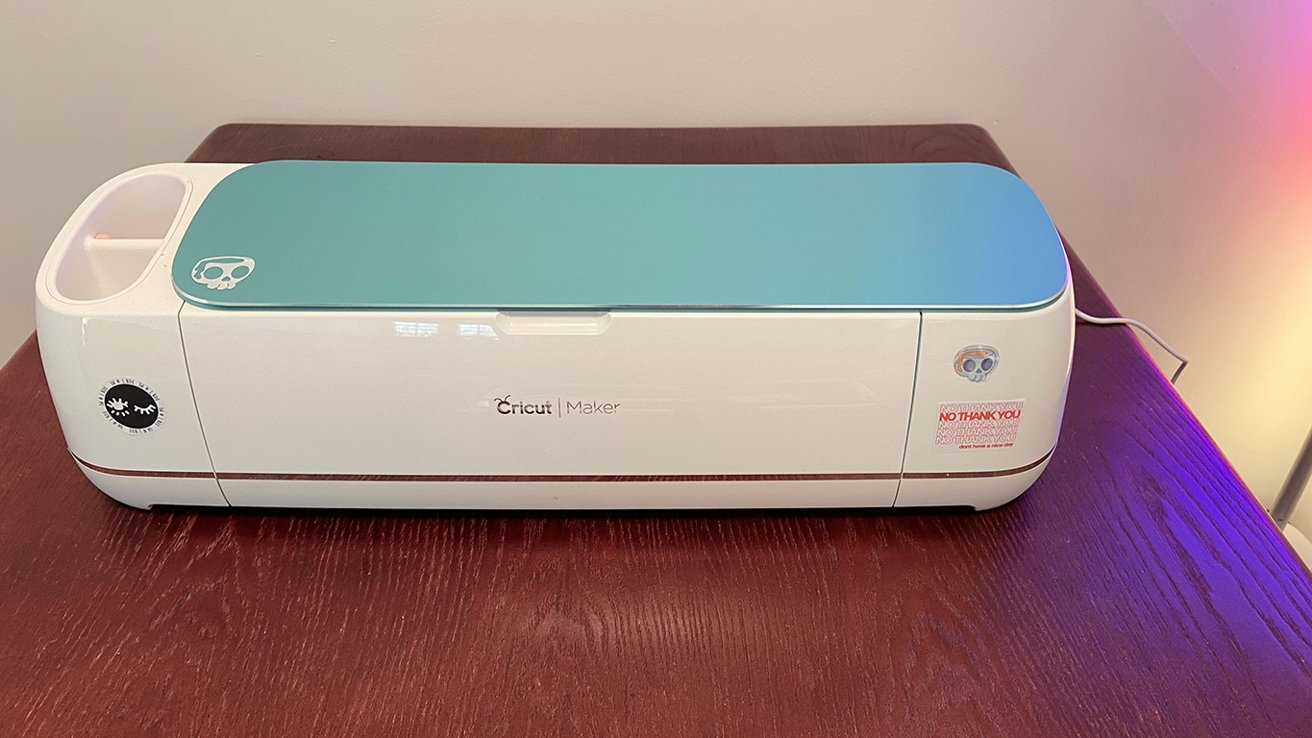
Cricut has come a long way from the mid-2000s. You may remember the first Cricut commercials featuring chipper women inserting clunky cartridges into something that looked like a combination of a fax machine and a toaster oven.
In the fifteen years since its launch, Cricut has expanded its capabilities considerably and added several new machines to its lineup.
One such device is the Cricut Maker. It's designed to take your crafting to the next level by adding in the ability to cut fabrics, chipboards, leather, and more.Setup
Before your Cricut even arrives, you should probably go ahead and register for a Cricut account and download the Design Space app onto whatever devices you plan on using your Cricut with. Design Space works with Mac, PC, iPad, iPhone, and Android devices.
Once your machine arrives, you'll use Design Space to set it up, which only takes a matter of seconds to do. I was pleasantly surprised that within five minutes of unboxing the Cricut, I was already cutting my first test project.
Yet, before we go into actual projects, let's discuss what you're really getting into when you buy something like the Cricut Maker.In for a penny, in for a pound
One of the most important things you need to realize before purchasing any craft cutting machine -- be it one from the Cricut lineup or from Silhouette or Brother -- is that it's hardly a cheap hobby.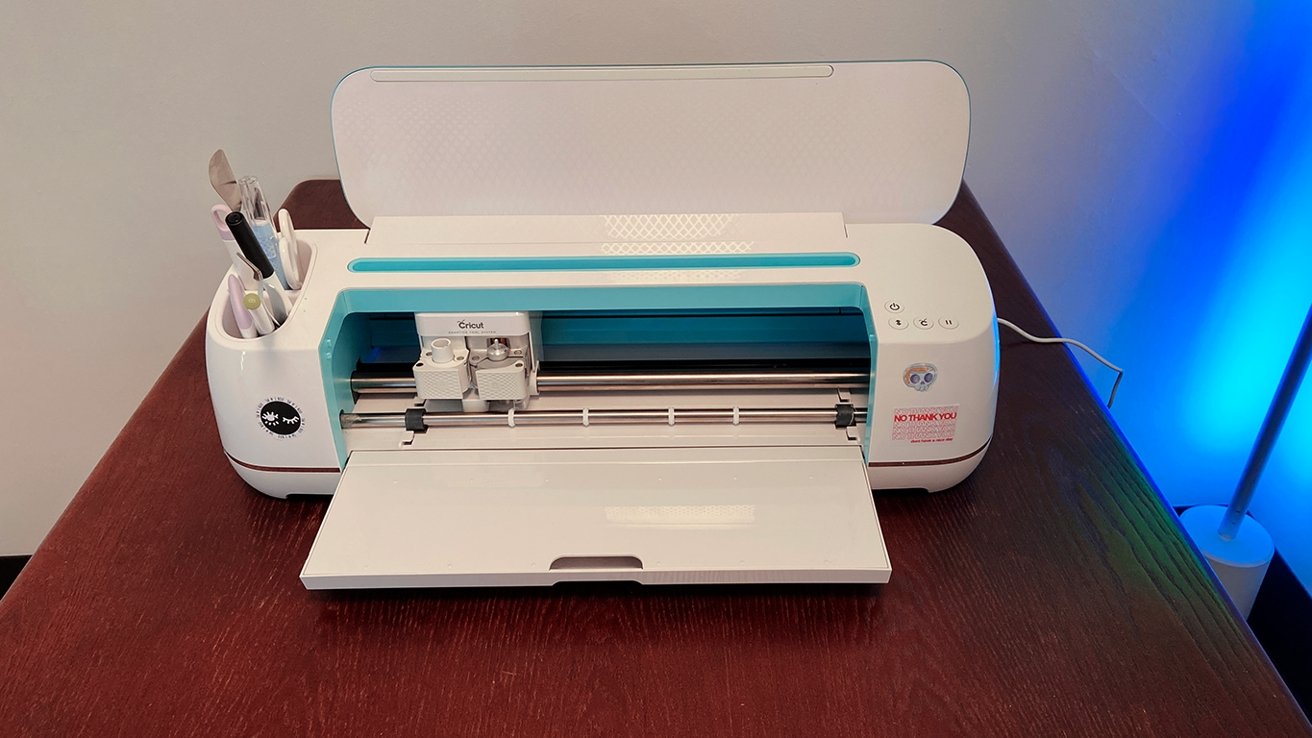
The Cricut Maker is not a cheap device by any means.
This is crucial for you to understand before proceeding forward. Not only is the machine an investment in itself, but everything you use with it is an added expense.
I scored my Cricut Maker on a steep sale -- $279 for the Cricut Maker Everything bundle -- and I've still managed to spend $70 on other things for it. To make matters worse, I'm not that far from dropping another $80 on additional cutting blades.
That's where a large portion of your expenses will come from. When you purchase a Cricut Maker, you get the machine, the Rotary Blade (for cutting fabric), the Fine Point blade (For cutting paper and cardstock), a Light Grip mat, a FabricGrip mat, a fine point pen, and that's it.
However, the Cricut Maker is compatible with thirteen tools, including the Scoring Stylus, the Scoring Wheels, Foil Transfer Tools, the Debossing tool, the Engraving Tool, and the Perforation Blade -- and that isn't even all of them.
Many of these tools are not only helpful but required for projects.
For example, I wanted to make some cards to give to family members for upcoming holidays. I figured, perhaps somewhat naively, that I'd be able to make do with the Scoring Stylus and the Fine-Point blade. As it turns out, not so much.
The Scoring Stylus, in my opinion, is essentially useless. It couldn't even score 80-pound cardstock, which meant I had to go back and manually score my cards with a blade by hand. Sure, it's not the end of the world, but finding out that my machine included a useless tool in a bundle I paid for was less than ideal.
Additionally, the everything bundle also includes foil poster board, which I assumed -- again, maybe a bit naively -- could be cut with the Fine-Point Blade because it was included in a bundle with my Cricut Maker. The blade did okay on some of the cuts, but some more detailed cuts tore out. As it turns out, many Cricut users note that you should only use the Deep-Point blade.
The Scoring Blades and Deep-Point blades are around $30 each. In fact, most of Cricut's proprietary blades are available at $30 apiece -- so the costs can add up quickly.
Fortunately, when it comes to things you can cut, you're not locked into Cricut's line of materials. Instead, you can head to nearly any craft store, to Amazon, or even your local Dollar Tree and be met with a fair amount of materials designed to be used with craft cutting machines.
If you're unsure if the Cricut can cut a specific material, just Google it. Someone on the internet has probably already tried to cut whatever you are interested in. Cricut's website has a helpful list, but it's hardly exhaustive, including 300+ items.
Of course, with it being a hefty investment, there are a lot of things you can do with a Cricut Maker.Getting to know the Cricut
As I've already explained, the Cricut is a machine that you use to -- ostensibly -- cut things. It's not dissimilar to a CNC machine, which you're undoubtedly familiar with if you've ever fallen down the YouTube maker or woodworking rabbit hole.
To cut things on a Cricut, regardless of model, you typically adhere the material you wish to cut (or draw, or score, or deboss) on a sticky mat. Then, you snap your favorite tools into the Adaptive Tool System, load the mat into your machine, and follow the steps in the companion software.
The original Cricut Maker can make incisions up to 12 inches wide and 24 inches long. As stated above, the manufacturer estimates the Maker can cut more than 300 materials, though that may be lowballing it. Pretty much, if you can cut it with a craft knife or a box cutter, you can cut it with a Cricut Maker.
Here's what you need to know about what makes your Cricut work.Mats
The mats sold by Cricut range in price from $3 to $18, depending on size, type, and whether or not Cricut or the retailer is holding a sale.
That is something to note -- Cricut items are very frequently on sale. It may behoove you to compare name-brand materials and mats with third-party items, as Cricut materials are occasionally similarly priced.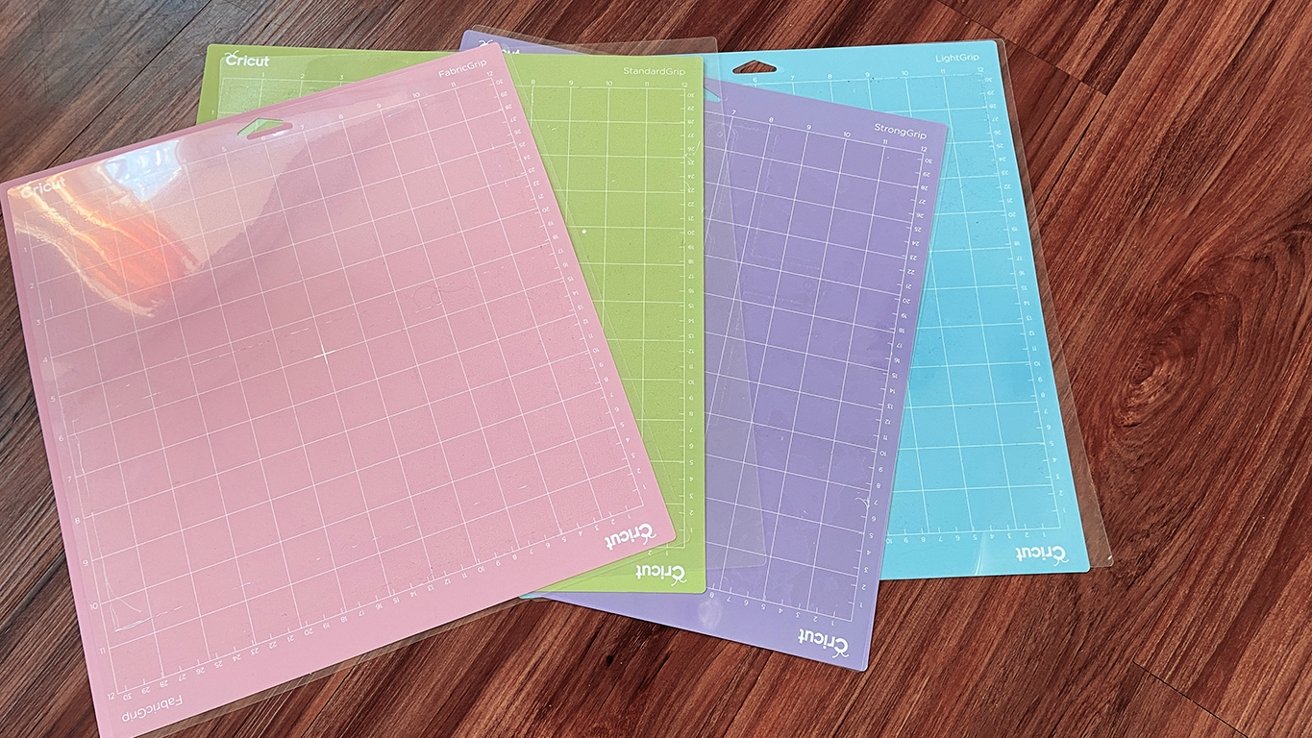
Cricut mats, from left to right: FabricGrip, StandardGrip, StrongGrip, LightGrip
The Cricut mats come in a few different types and sizes, and they are rated by grip strength.
Some materials, such as balsa wood, require you to use a StrongGrip mat to ensure the Cricut doesn't pull the material free while applying extra pressure during cuts. Other materials, such as wrapping paper, require a LightGrip mat, ensuring that the material won't tear when removed.
The mats inevitably become gunked up with bits of paper, fuzz, hair, glitter -- making it less effective. Fortunately, you've got a few options.
For example, if a StrongGrip mat loses some of its bonding power, many users choose to "downgrade" it and use it for more delicate materials. This practice is prevalent for people who use their Cricut as part of their business.
Others, like me, gently remove larger pieces of debris -- like paper bits and fabric by hand. Afterward, I throw it in my sink and wash it with warm water and a little bit of hand soap. Washing the mat removes any remaining stray fuzz, hair, or microscopic bits of paper free from the adhesive.
Once dried, the mats return to their former glory, more or less.Blades, tools, and the Adaptive Tool System
The Cricut Maker has two tool slots it can use at any given time. Clamp A, which is plastic, is used mainly for Cricut pens and the scoring stylus. Clamp B, which is aluminum, is used with blades and scoring wheels.
There are a lot of tools for the Cricut Maker. While I'm not going to delve into every tool available, I will discuss how a few of them work.
Cricuts Adaptive Tool System, aka, the tool clamps
You'll need to clamp in the correct tool whenever you set up a cut on your Cricut. For most projects, you're either going to use the Fine Point blade or the Deep Point blade. Both are analogous to craft blades. You'll use these to make cards, cut pleather, cut certain fabric types, and most vinyl -- they're your workhorses.
The Rotary Blade, which comes with -- and is exclusive to -- the Cricut Maker, is used to cut fabric. As it turns out, the Cricut Maker maker has a pretty big following in the quilting community. The rotary tool allows artists to precisely cut fiddly bits of fabric without relying on stencils.
There is also a Knife Blade, which can be used to cut thicker materials, including leather, balsa wood, basswood, and chipboard.Cricut's line of non-cutting tools
Like any good crafting giant, Cricut also sells a fair amount of things to go along with the Cricut to expand its capabilities.
Many of these are known as "weeding" tools, which you'll use to "weed out" bits of material from your cut design. Scrapers, weeders, and tweezers fall under this category.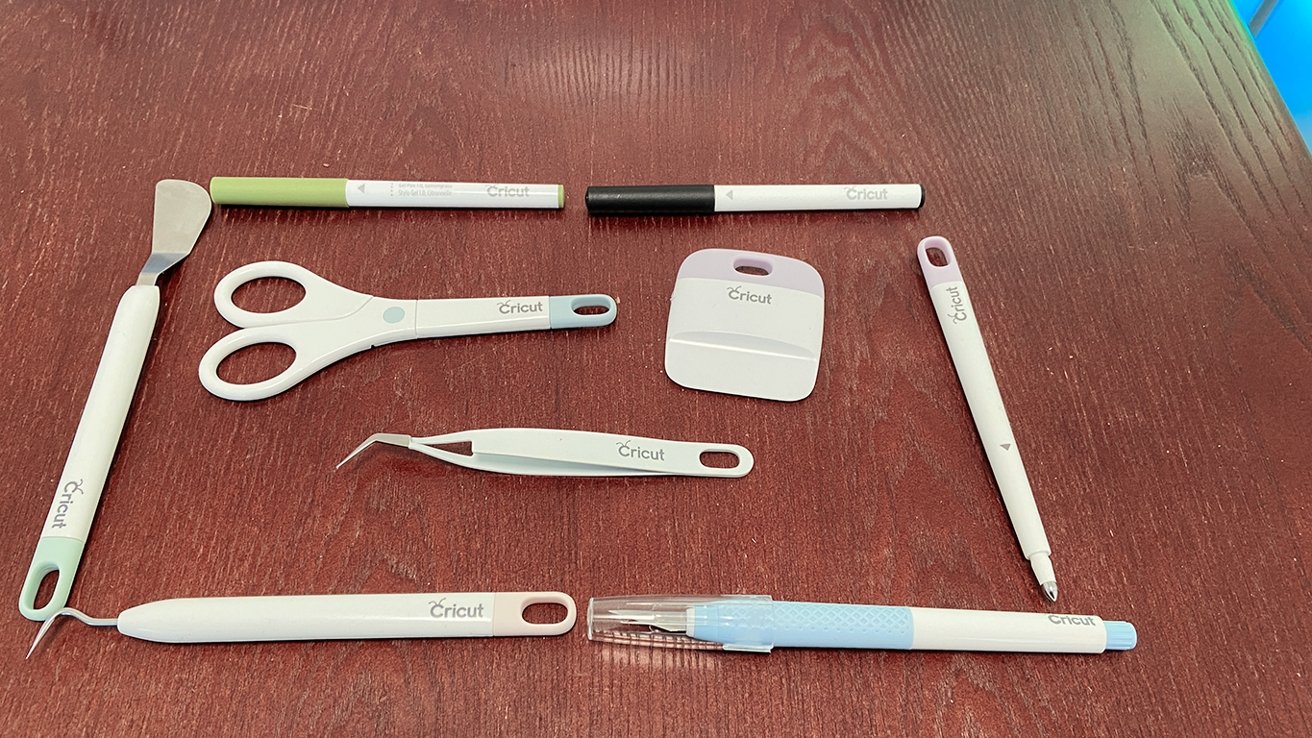
Cricut pens, weeder tools, scrapers, and a Cricut-branded craft knife
You absolutely do not need to buy these tools -- the only reason I own them is because they came with the bundle. A friend of mine pointed out that dental plaque scrapers are just as effective and often cost less.
Additionally, the market is flooded with third-party sellers that you can find on just about any selling platform.
There are a few other tools that Cricut offers, including Heat Presses for iron-on vinyl transfers, a Brayer for helping to place materials on mats, and a whole line of markers you can use with the Cricut.Cricut Design Space -- surprisingly decent
Now that I've covered your Cricut's physical aspects let's take a look at the brains of the operation.
Provo Craft, the makers of Cricut, have done a really good job of preventing any third-party software from accessing the Cricut hardware. Unfortunately, that means you'll have to utilize Cricut's Design Space, at the very least, to cut your design.
Design Space is available on Mac, Windows, iPhone, iPad, and Android. I typically use it on my iPad, which is excellent because the Cricut made a slot for holding your iPad on the machine itself.
The iPad app is also fantastic, and there's enough screen real estate on my iPad Air 4 to effortlessly zip through the interface and do what you need.
I do, occasionally, use the app on my iPhone, but it's significantly more cramped on the smaller screen. I find this to be perfectly fine for quick prints that don't require me to change tools.
I haven't managed to try Design Space with my iMac yet, as my Cricut is housed in an entirely different room.
Still, I've been pleasantly surprised with Design Space. The interface is somewhere between computer-aided drafting (CAD) software and Adobe Illustrator, but nowhere near as complex.
While it may look intimidating at first, it's pretty easy to figure out how to upload design files, scale your image, and change tool functions without explicit direction.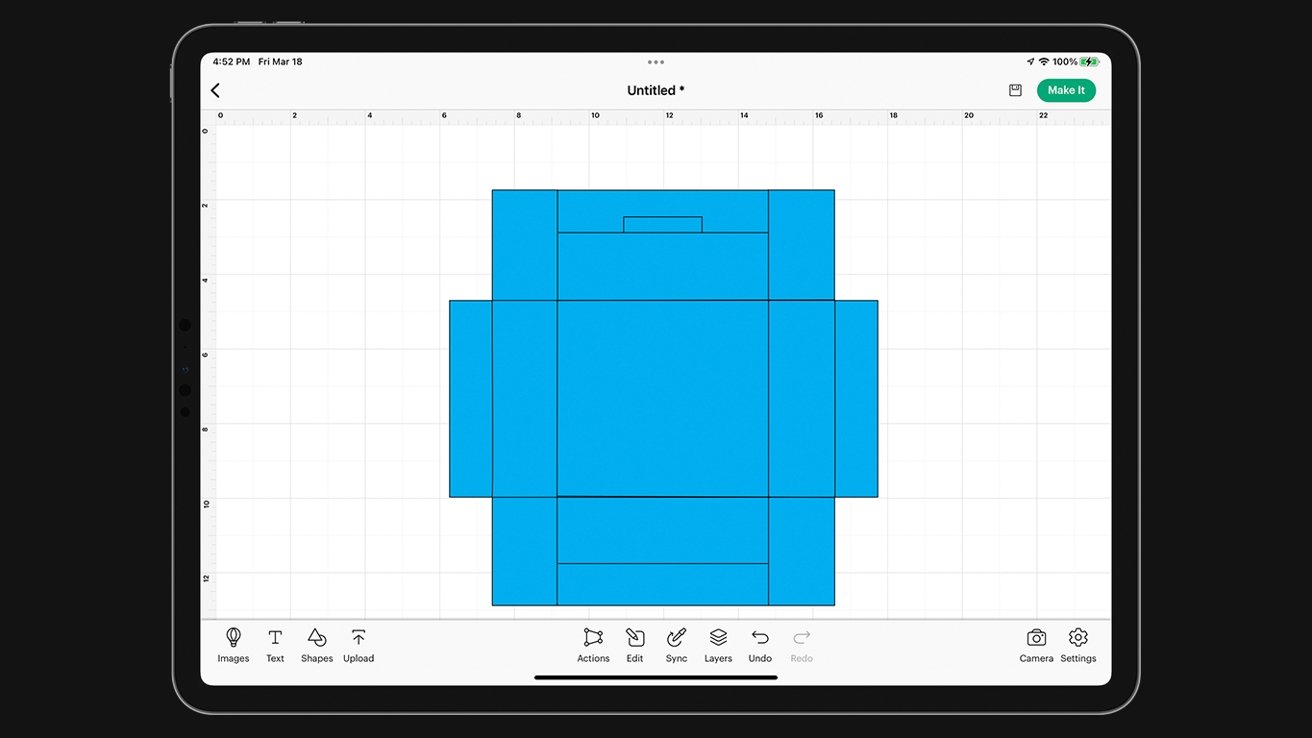
In fact, even though I'm apparently entirely averse to reading directions of any kind, I haven't hit that many snags. Those that I have run into have been either altogether solvable on my own with a little bit of trial and error or with a quick Google search.
For a lot of casual Cricut users, Design Space will be good enough. After all, the app allows you to quickly purchase ready-made designs, allowing you to complete an entire project without ever altering a design once.
However, for the more ambitious users, you're definitely going to want to make use of other options.Designing your own project files
While it's true that you can't access the Cricut hardware with third-party programs, that doesn't mean you're limited to using Design Space when it comes to making project files. In fact, you've got pretty much endless options for creating designs that can be imported.
The only fundamental requirement for cut files is that they must be in the correct format.
Design Space accepts a handful of different file formats under two broad categories.- Raster: .JPG, .PNG, .BMP, .GIF
- Vector: .SVG, .DXF
If you're doing a complex cut, such as a multi-step card that involves drawing, scoring, and cutting, you'll absolutely need to utilize a vector file.
I'm not going to give you a complete rundown on how to use programs, but I will point you in the right direction on where to find them.
Programs that can make raster images run the gamut from expensive to free and include programs like Adobe Photoshop, Affinity Photo, Pixelmator Pro, and Procreate. In fact, we've got a whole list of Photoshop-like programs that you can use to make and edit raster images. Many of these programs have both iOS and macOS versions, too.
Programs that can make vector images include Adobe Illustrator, Affinity Designer, and Inkscape. We also have a list of our favorite vector design programs that you can check out, too.
If you already know how to use CAD software and your software of choice exports .DXF files, you can give that a go, too. Fusion360 is one option, but I'd bet that most CAD software would work just fine.What you can make
Cricut often highlights the hobbyist-meets-crafter side of things you can do with your Cricut. This includes making cards, cutting vinyl for wall decals and shirts, or designing labels for items in your home.
But the Cricut Maker can do so much more than that. A quick trip to Google will show you that tons of people out there pushing the limits of what has been done with the machine.
I found myself most excited for practical reasons. Since getting the Cricut in February, I've made desk organizer boxes using cardstock, cord keepers using pleather, and two tool rolls.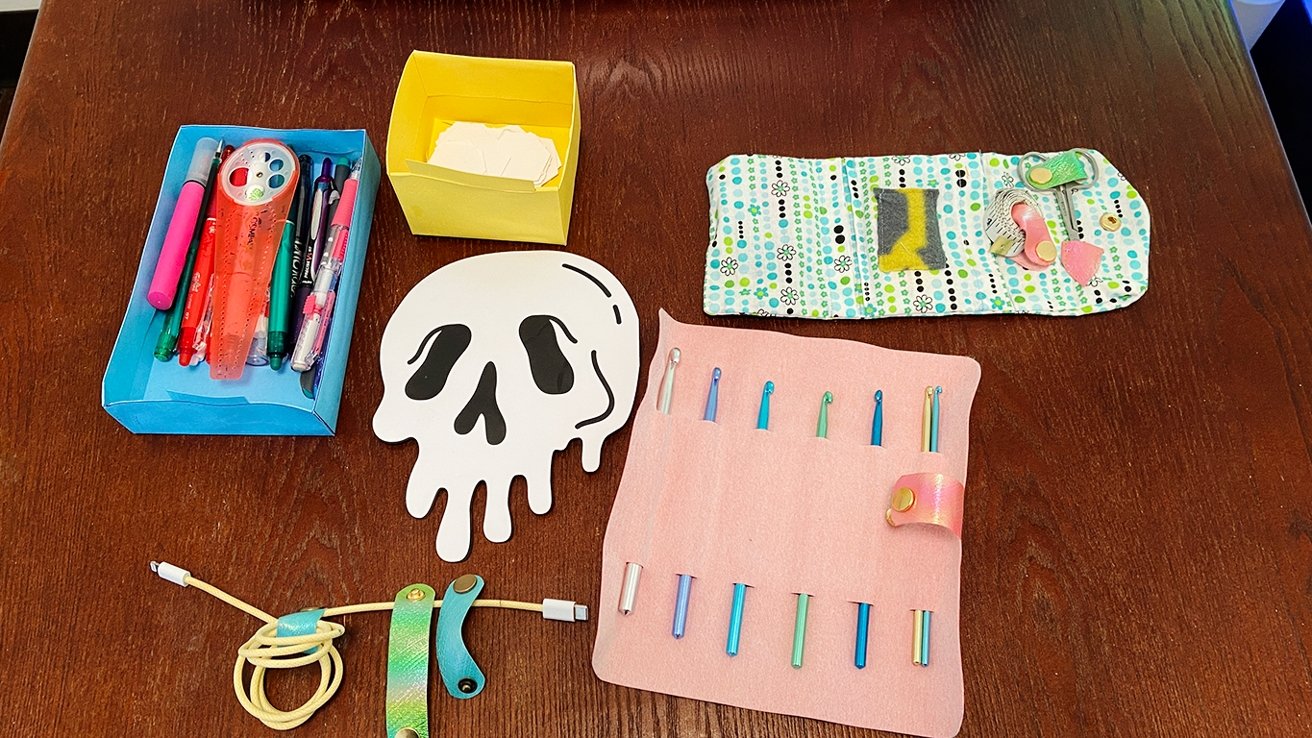
A very small selection of things I've made with the Cricut
Eventually, I hope to snag some cheap acetate to make clear storage boxes to help keep some of my larger craft boxes more organized.
The Cricut has become an indispensable tool for many textile artists who make quilts, toys, and garments using the Cricut for precision cutting, particularly fiddly bits. As an aside -- Cricut also sells a fabric pen, allowing users to transfer patterns to fabric quickly and accurately.Shortcomings
While the Cricut is an extraordinarily powerful machine in a relatively friendly package, there are some shortcomings I've noticed. The biggest issue I've found is that the Cricut "Print, Then Cut" feature is not the greatest.
This feature is designed for artists looking to do small-scale production of stickers, magnets, labels, and the like. It involves you printing your designs with your printer, throwing it to the Cricut, and then the Cricut reads registration marks to -- and I say this loosely -- "accurately" cut out your design.
In theory, this is pretty cool. It's a fast way to make sticker sheets or homemade labels. It's a handy feature for artists who aren't ready to commit to sending their art out for print through a third-party distributor.
Unfortunately, you still need to print your designs through Design Space, which means you've got no control over the DPI and minimal control over the print quality.
Additionally, depending on the material you're cutting, the Cricut might not accurately cut out Print, Then Cut designs. To its credit, Cricut warns users about this, stating that metallic, ultra-glossy materials or those with a pattern might not work.
Unfortunately, most printable waterproof vinyl is shiny, so you risk your designs not cutting correctly because you wanted to make stickers that have some longevity.
I continue to routinely waste some fairly expensive holographic printable vinyl I purchased because I've not learned my lesson.
Additionally, suppose you print anything with a dark color too close to the registration mark. In that case, it's highly plausible that your Cricut will assume the artwork is the registration mark, which throws off where it cuts.
The other notable problem is that you are locked into using Design Space. While Design Space is decent, it's certainly not all it could be. Because Cricut's core demographic tends to be crafters, it is catered toward lighter, more straightforward projects.
This is great if you're someone who owns an entry-level machine, like the Cricut Joy or Cricut Express Air. However, if you've invested in the Cricut Maker line, you might feel a bit hamstrung.
The Cricut Maker is an extremely powerful tool. If users had access to software that allowed users more control, or a more robust design space, it would open up the product to an even wider audience.Overall
The Cricut Maker is a tool that I'm incredibly impressed with, even though there are a few hangups here or there. If you're a person who genuinely enjoys making things, there are many ways to use it beyond just making cards or shirts. If you run your own small business, it's a great way to make your own small batches of merchandise or stickers.
Just be aware that the Cricut is hardly a cheap hobby and that once you get started, it can be kind of hard to stop.
Pros:- Beginner friendly
- Wide range of available tools
- Cuts more than 300 materials
- App is reliable, easy to use on iPad, iPhone
- Third party products bring down price
- Cutting blades are expensive
- Can only use Design Space to perform cuts
- Print, then Cut feature is severely lacking in options
It's difficult to accurately rate a project that can be utilized in such a wide variety of ways. Many of the flaws I see with Cricut are only applicable to a more advanced user, and a hobbyist may not see an issue with it whatsoever.
For general purpose: 4 out of 5
For advanced users: 3 out of 5Where to buy
You can score your own Cricut Maker starting at $229 from Amazon, with a bit of variation depending on the color. Cricut itself is offering discounts on Maker bundles.
Read on AppleInsider




-
Tim Cook isn't going to get fired, and Steve Jobs isn't rolling over in his grave
Tim Cook is constantly criticized, most recently over Apple Intelligence and how Apple hasn't bought Perplexity, and how he isn't Steve Jobs -- yet the fact that he isn't Jobs is what has made Apple the technological and financial juggernaut it is today.

Tim Cook (left) with Steve Jobs -- image credit: Apple
There was criticism right back at the start in 2011, when Tim Cook was no longer the temporary stand-in for Steve Jobs, but was getting the CEO job permanently. Today there's criticism of Cook over how Apple Intelligence has seemingly stumbled.
And in between, say around 2018, there was criticism for the now forgotten weak sales of the HomePod. Plus before even then, the Apple Watch was branded a failure, it was called a device without a point.
No living CEO of any company is universally praised, and it took Steve Jobs's passing until he was truly beloved. But then after his death, it was revealed that Jobs didn't think his replacement was a product person, and it's not as if Cook could exactly argue.
Cook's tenure at Apple has seen the launch of a slew of products that now help define the company. He's spread the company wider, predicting that services would become crucial.
And he's also taken Apple first to a $1 trillion valuation -- and then to a $3 trillion one. In both cases, it was the world's first company to reach those milestones.
Yet after the first one, Cook took time to repeat the kind of argument that Jobs had often made before. Jobs would claim to not think about money, and trust that if you do good work, the results follow.
"Financial returns are simply the result of Apple's innovation, putting our products and customers first, and always staying true to our values," Cook wrote in a memo to staff about Apple reaching $1 trillion.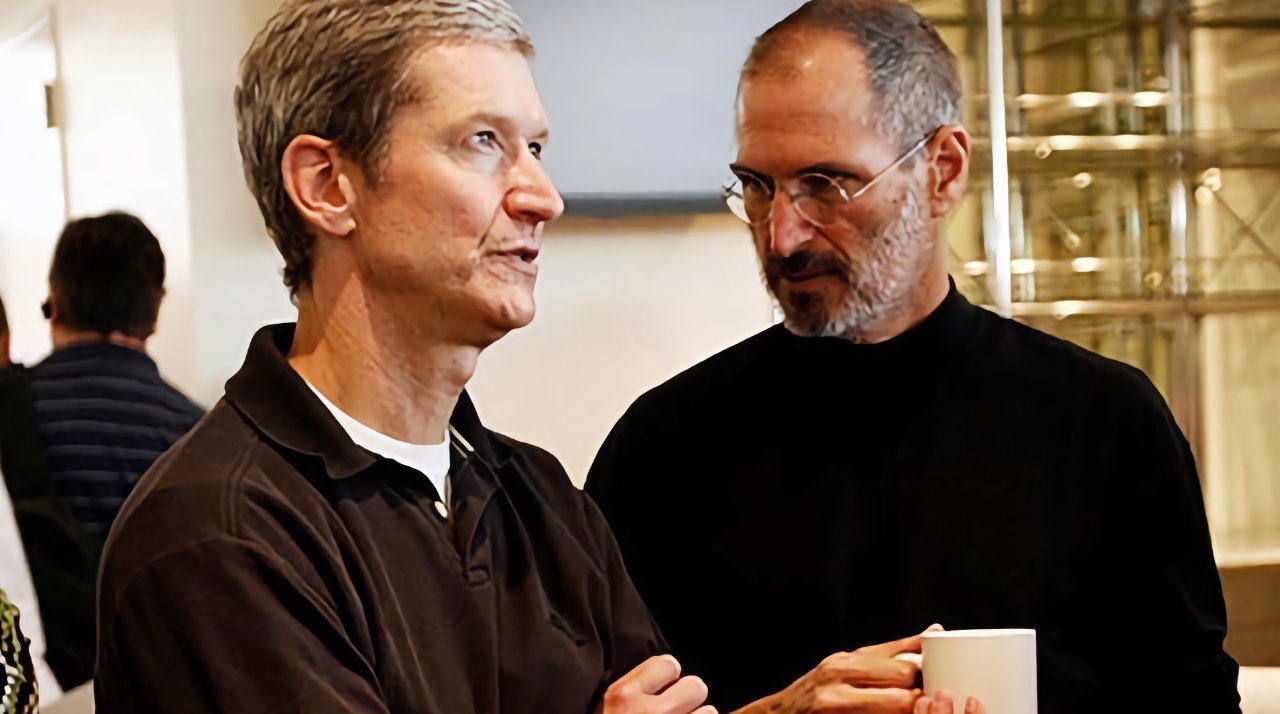
Tim Cook (left) with Steve Jobs -- image credit: Apple
"Steve [Jobs] founded Apple on the belief that the power of human creativity can solve even the biggest challenges -- and that the people who are crazy enough to think they can change the world are the ones who do," Cook continued. "Just as Steve always did in moments like this, we should all look forward to Apple's bright future and the great work we'll do together."Financial success gives Apple an edge
Money isn't everything, but it's a lot. Apple has grown so much under Cook's aegis that it's actually hard to definitively say, for instance, what your shares would be worth if you'd bought $1,000 of them on the day he took over.
However, if you ignore additional money from the dividends Apple has paid shareholders over the years, you can get one measure of the company's growth. A $1,000 investment in 2011 would now be worth around $18,500.
That's nice for shareholders, and the board. It's also a very clear sign that Cook will never be forced out.
It's also's Cook's financial acumen that has put the company where it is now. It's because it has this money that it could scrap the decade-long Apple Car project. That money wasn't thrown away, it was spent on material science, on computer vision, and so forth.
And all that will be, and has been, used in other Apple products. That cash reserve is how Apple can play a long game and profit from that Apple Car research, despite it being a cancelled project.
It's because it has this cash and such a strong financial base that Apple can out-wait any rival over any issue. This is also why Apple is then able to repeatedly be late to a market, yet then totally own it.
Apple thinks of what technology can be used for, and how it can be used, rather than creating technology first and trying to find users. So by the time it enters a market, it has spent years thinking about it while other firms have become entrenched in whatever their first idea was.
Consequently, Jobs may well have meant it when he kept saying that money wasn't the focus. It is money that enables Apple to focus.
Plus, never forget that right back at the start of Apple, it was Steve Wozniak who wanted to give away his blueprints at the Homebrew Computer Club -- and Jobs who insisted on selling them.
So Jobs was far from unconcerned with money, and far from being willing to let some potential profit go.Steve Jobs is not turning in his grave
Still, you can, and folks critical of Cook repeatedly do, make any point you like about Apple and then add that Jobs is turning in his grave. Steve Jobs would never have done this or that. Steve Jobs would never have had a failure like Apple Intelligence, and so on.
That he did have, say, Antennagate, but the truth is that no one does and no one can say what Jobs would or wouldn't have done.
You can compare, say, his response to the iPhone 4's antenna problems to Tim Cook's reaction to the poor launch of Apple Maps. And you could make some parallels between how Jobs dealt with the failure of Mobile Me to how Cook now appears to be dealing with Apple Intelligence.
And Jobs had his other failures too. The predecessor to the Mac, the Lisa, was a spectacular one.
But yet, Apple waited.
Anyway, you cannot predict anyone, and it is impossible to even really guess how Steve Jobs would be acting if he were facing today's issues given that he has been gone for over a decade. You cannot predict, nobody can, how he'd manage a company that has grown at least eight times in market capitalization, but actually more, given stock buybacks and so forth.
Saying "Steve Jobs would never" or similar permutation is a logical fallacy. The argument is almost always used by somebody who personally disagrees with Cook's approach to something.
According to then-Apple board member Al Gore, Steve Jobs himself said no one at the company should ever ask "what would Steve had done?"
Because, simply, nobody knows. Not even those closest to him.
And don't forget -- Cook was hand-picked by Jobs. Cook is literally the man that Jobs wanted running the company after he was gone.Moving on from Steve Jobs
Whether under Jobs or Cook, Apple only rarely looks back at its past, at least publicly. But it does now routinely make an exception for Steve Jobs. Cook puts out statements on every anniversary of Jobs's death, and on his birthday.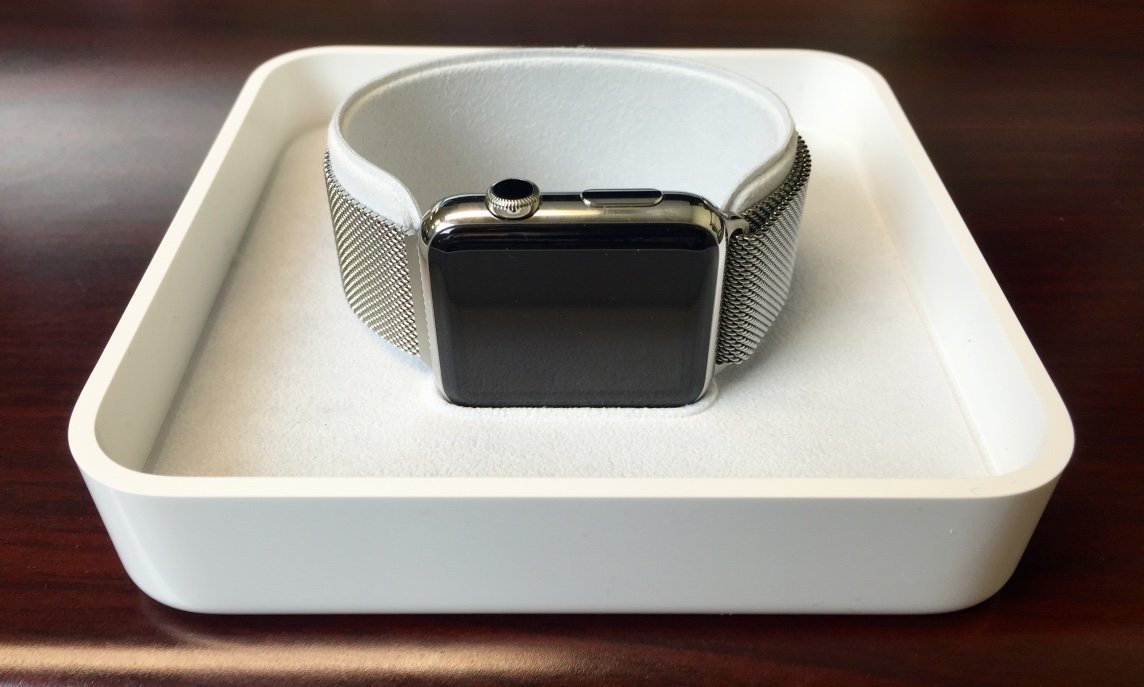
An original Apple Watch from 2015
Then together with Laurene Powell Jobs and Jony Ive, Cook helped launch the Steve Jobs Archive in 2022.
But if people criticize Cook now, they tend to do it by saying Apple would or wouldn't have done something if Jobs were still alive. Or they say that really Apple is coasting on the success that Jobs created.
What that really means is that Apple launched the iPhone on Jobs's watch and nothing since then has come close to its success. That's fair -- and also unfair, since the iPhone is the single biggest selling product of any kind, in the world. Ever.
And if nothing can match the iPhone's sales numbers, Apple under Tim Cook has regularly equalled that device's success in terms of ubiquity. Despite being so often called a failure, there is simply no smartwatch that rivals the Apple Watch, which Cook announced in 2014.
That wasn't the first smart watch in the world, just as the iPhone was far from the first smartphone. In both cases, though, Apple's device became the one to beat.
And it was the same with AirPods. While Apple wasn't the first to produce wireless earbuds and today there are many competitors, but AirPods set the standard.
Left: an unactivated AirTag. Right: an activated one in an accessory
So did AirTags. Yet again, there were trackers like it before, but now AirTags is the common term for all of them, and now they are a global hit.
Only the HomePod, Apple Pencil, and Apple Vision Pro have failed to become ubiquitous. But while no figures, or even really recent estimates, are available, you know that their sales would surely sustain most small companies.
And you suspect that right now, Sonos would like to have the HomePod's sales for its audio devices.The products keep coming
Then there have been significant developments of devices that originated under Steve Jobs's watch -- such as the iPad Pro. There is an argument that it is only in 2025 with iPadOS 26 that the iPad Pro truly became a pro device, but tell that to the artists who've been using since it launched in 2015.
The long-standing criticism of the iPad Pro was that the hardware was vastly more powerful than the software. But key to this claim is how Apple pushed ahead with making an ever-more powerful tablet.
And that ties in to one more thing that Cook has done for Apple which was and is revolutionary. He moved Apple on from Intel to its own Apple Silicon processors, and the difference for the Mac has been transformative.
Curiously, though, this is perhaps the single area where a direct comparison can be made between Tim Cook and Steve Jobs. They both pulled off an immensely complex move of processors -- with Jobs taking Apple from PowerPC to Intel -- and both did it so well that it's easy to forget what a task it was.
In this one case, Tim Cook appeared to follow Steve Jobs's playbook to the letter, sometimes even using the same words in presentations.It's a new world
If Cook is still believed to not a product person in the way that Jobs or Jony Ive would obsess over them, he is said to claim that he uses every product, every day. Steve Jobs famously cut Apple down to four main products, but under Cook the firm has ballooned.
There was no Apple TV+ under Jobs, for instance. Nor Apple Music, nor Apple Arcade, Apple News, and definitely not films in movie theaters.
And if Cook oversees so many products that he cannot truly obsess about them all, there have been reports that he obsesses about one of them. In early 2025, an anonymous source claimed that Cook "cares about nothing" except the Apple Vision Pro, and more recently the company is said to have seven devices in the works.
Tim Cook dons the Apple Vision Pro | Credit: Vanity Fair
Cook sees a world in which spatial computing is everywhere. But then Cook is also working in a world now that requires him to be something that his predecessor could chiefly afford to ignore.
Tim Cook is a politician.
That does now include all of his dealings with Trump -- both successful and unfortunately also not -- plus he will lend his voice to lobbying officials.
But it's also visible in his interviews. Whether he's criticized, or it's put to him that Apple is doing something wrong, he has a very well-crafted phrase that he leans on.
"The way I see it..." he'll begin, before presenting how Apple would like its actions to be perceived. It's such a short phrase, but it's armed -- he won't disagree with you, won't challenge you, will just so very reasonably present an alternative and make it sound personal.
Cook is usually said to be reasonable and calm and even unflustered. There has been evidence that Cook isn't so calm as to be a pushover, though.
And there has been evidence that he doesn't follow Steve Jobs's example or even preferences.
The clearest example of both of these, though, is in how in 2012 he fired Scott Forstall, despite him being a favorite of Jobs's.
But then you don't get to run a $3 trillion company by trying to keep everyone happy. You do it by having "the skin of a rhinoceros," which Cook once said "comes in handy when you're the CEO of Apple."
Sure, you can wish Cook to be gone, you can yearn for a halcyon idealized past where Jobs never had a failed product release or a fumbled product. All those wishes are, is looking at Apple through six-colored glasses yearning for a past that never existed, and a future where your own perfect Apple, your own perfect Apple product, can't and won't exist because there are more workflows than your own.
We know that Apple swings by AppleInsider routinely. Beyond IP logs, we get the periodic nastygram email or call when we criticize them, or they don't prefer a coverage angle we take.
And, we know that they read our forums, and poke through social media. We know that they see some of our more vocal commenters calling for Cook's ouster.
We also know, as we've been told, that they get a kick out of the mental contortions and verbal gyrations that some of the Cook bashers go through to justify their wacky arguments.
Cook is here to stay, regardless of what you, or I, or stock analysts, think. Most recently, a note to investors from the Wedbush financial services firm shows that maybe analysts are coming around to seeing that Cook alone will decide when it's time to go.
In the note concentrating on Apple Intelligence, Wedbush analyst Dan Ives says that its analysts expect Cook to remain CEO of Apple for at least another five years.
He also believes that, between tariffs and AI, it is this moment that will be what Cook is remembered for -- whether that's for good or bad. Ives has a good track record with Apple predictions, although he's demonstrably misunderstood Apple Intelligence if he really believes Apple should replace it with Perplexity.
Cook has earned the right to stay as long as he wants, based on what he's accomplished, and, frankly, the immense wealth and success that he's generated for shareholders and the company.
Update July 30, 2025 Updated with Wedbush's prediction about Cook staying at least a further five years.
Read on AppleInsider








-
New M4 MacBook Air fixes the line's biggest problem
The new M4 MacBook Air fixes what's been a key problem with the line, and now supports up to two external monitors -- and does so without the limitations of the previous M3 edition.
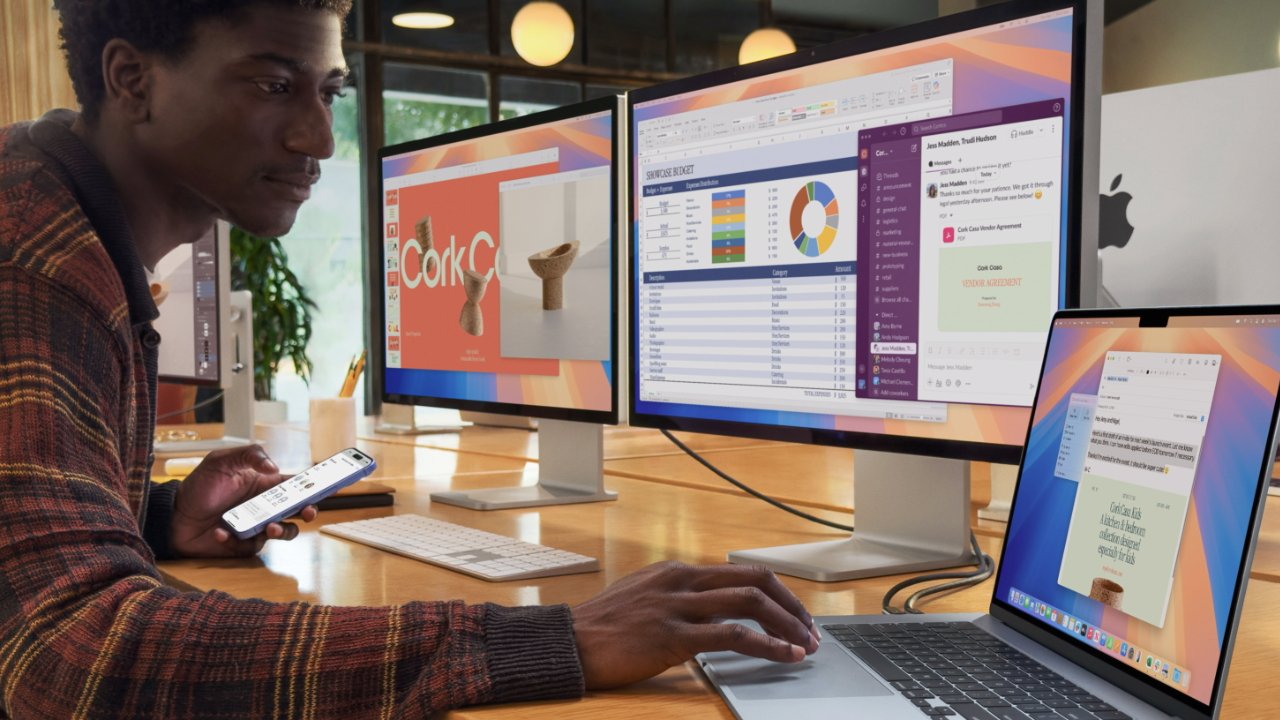
Using two external displays plus the MacBook Air's own screen
The newly launched MacBook Air brings with it a significant improvement for users of multiple monitors. While the previous M3 model featured support for two monitors, it was only possible to use both when the MacBook Air's lid was closed.
So while users gained the wider screen real estate of two external monitors, they lost the use of their MacBook Air internal display. Now the M4 MacBook Air supports two monitors of up to 6K resolution each, plus the built in 13.6-inch or 15.3-inch screen.
That 6K resolution is also an improvement. The previous model did support two external monitors, but only one could be 6K.
The other could be driven at up to 5K resolution at 60Hz. Either screen could be run at 4K resolution at 144Hz.
For comparison, the current M4 MacBook Pro introduced in October 2024, has the same 6K two-monitor option as the MacBook Air, without the lid shut. But the MacBook Pro with M4 Max processor can drive up to three 6K monitors at 60Hz, and a fourth at 4K up to 144Hz.
Read on AppleInsider


-
Using Unity with ChatGPT on macOS for vibe coding is dangerously easy
AI has made it somewhat easier for non-developers to create apps but using ChatGPT with Unity in macOS, but it won't turn you into John Carmack overnight.

ChatGPT and Xcode working together in Unity
The growth of AI chatbots such as ChatGPT has made considerable changes to knowledge-centric industries. Instead of needing to know how to do difficult tasks that require years of effort, you now have a way to get the job somewhat done by asking an app to do it for you.
As a person who writes for a living, I'm intimately aware of how good AI can be when crafting text on a subject, and I'm not a fan. It's not perfection, and makes Google summaries frustratingly mostly-wrong compounded by searchers just bouncing off summaries that remain mostly uncredited.
That said, things like Apple's Writing Tools are pretty good at performing simple writing tasks for non-writers.
I also know how AI can be disruptive to visual arts too. My artist partner and AppleInsider's own artist-in-residence Brian Patterson have previously discussed the various dilemmas surrounding AI art, copyright, and attribution.
Obviously, AI services can do a lot, and get you most of the way to completing a large task. But at the same time, you may get more benefit from using it as a learning tool, so you can perform those same tasks for yourself.
Thanks to some external prodding by my boss Mike Wuerthele, I ended up going through my own experience working with ChatGPT to work on something I've wanted to do for decades.
Making a game.Game-changing education
The reason I started using ChatGPT for game production was because of my partner. She is doing a master's in game development, and her group was tasked with making a game.
As the more technically minded person of this small household, and based on previous occasions, I anticipated that she would be asking me questions about development at some point. Inevitably, I wouldn't know the answer or have an idea of where to go with the query, and feel useless.
Since she would be using Unity as part of a group to make small games as part of the course, I figured that I should learn how to use it so I can at least try to help her out.
I'll admit that my background isn't in development at all, but I'm not completely starting from zero. I have a HND from the University of Glamorgan in "Computing" I was handed in 2004, which means I have some experience working in things like PHP, a bit of C++, and some very basic programming concepts.
ChatGPT was able to work out what I needed to code based on my request.
The usual route would be to look at the many YouTube and online guides to learn how to use Unity itself, as well as to write in C#. There is a lot of manual pages for all of the various functions available within Unity, and it would take a long time to learn that way.
I figured that one of the best ways forward was to make my own small game. A low-in-scope app that lets me learn the absolute basics as I go along, gradually turning it into a full product.
That project would be a word game. A 2D affair, instead of jumping straight to the tougher 3D-based games that are a lot more attractive to a first-timer.
While using Google-fu would be the old way of doing things, I also figured that I could try to take advantage of an actual tutor. Or, in this case, ask ChatGPT for help.Good vibe coding
ChatGPT has the capability to write code, and it also has the ability to understand game engines. As it will have scanned practically every page of the Unity manuals and guides on the Internet, it is going to be a very well-versed developer's assistant.
The idea was that I would ask ChatGPT to help me learn by asking it how to do a small task, and requesting it to explain the thought process behind it all. It would explain concepts and why things were being done in a specific way, and the project would be constructed gradually.
I outlined the basic idea of the word game to ChatGPT so it knew what the basic idea was, and I asked it to come up with a basic plan of action to get the basics of the game in place.
In return, it came up with a multi-phase plan, complete with generalized instructions for each section. Surprisingly, it also included code snippets I could either write for myself or to copy and paste directly into the script files.
Indeed, if I didn't want to actually touch the code, I could instead allow ChatGPT to directly edit the files for me. In March, an update to ChatGPT allowed it to read files open in Xcode, and to make changes directly to the code for you.
If you want, ChatGPT can enter the code right into Xcode.
This can certainly save a lot of effort for an intrepid or lazy coder. You could explain in simple terms what you want ChatGPT to do, and it will do it for you in Xcode.
This is what is referred to as Vibe Coding, a recently emerging technique where developers focus on the "vibe" of the app itself and leave AI to handle the actual implementation.
Vibe coding does offer users the capability to make apps by themselves when they have little experience. It's not hard to see it being used to create simple apps, both for experienced coders and newbies to the field.
However, there is a danger with the technique. By leaning on AI to do all of the code, a developer can certainly get the work done, but a new developer may not necessarily learn much about coding from the experience.
I tried to steer clear of utilizing vibe coding completely, as this was meant to be a learning exercise for me. I did ask it to implement code a few times to try it out, and I can see the allure, but it's not great from a learning standpoint.Fixing the broken - or, why "Error near or before end" isn't a thing anymore
While I wasn't prepared to allow ChatGPT to completely write an app for me, I was allowing it to guide me through gradually producing a game from scratch. It helped with letter spawning, timers, win/loss conditions, and even checking words against a word list.
Working gradually also allowed me to test the game at each stage. I was glad that I went down this route, as it enabled ChatGPT to shine in another way.
When a problem arose, I was able to tell ChatGPT that there was an issue and describe it to the app. Occasionally, this was caused by blips in ChatGPT's code, and sometimes it was human error.
Remembering the previous steps taken in development, ChatGPT would diagnose probable causes for the fault and things to check. Even better, if there was an error within Unity, I could copy and paste the log into ChatGPT, and it would have more data points to determine what happened.
ChatGPT even helped with troubleshooting.
In cases where it's an issue in code, ChatGPT would offer a copyable refresh of a script, which could then be pasted into place and fix the problem.
That connection with Xcode also came in handy, as I could ask it to check any code I had written myself. It would check for errors, and even provide ways to improve what's there, complete with explanations.
It was probably a good thing that I checked throughout the project. The last thing you want is to do all of the work in the hope it all works, but then find a really difficult-to-find error right at the end.
Smaller haystacks are better when searching for needles. Even with the help of ChatGPT.
Even if we ignore the relative ease of using ChatGPT for vibe coding, asking it to check code for issues and improvements could be a game-changer.
I would hate to imagine checking through thousands of lines of code to find the one mistake that's causing everything to fail. I may not have an intern I could pass the task onto, but ChatGPT acts as a digital one for me.A good start
After probably about six hours of effort across a few evenings, I managed to get to what could be technically described as a game. It had a game-over condition, it checked that entered words were on an acceptable words list, and letters were added to the rack in a random way.
What ChatGPT helped me make is far from what you would actually consider a full game experience. It's a basic screen, not flashy, missing sound and music, and many other things that you would expect from any sort of game.
It is a functional game. Technically. If you squint at it and tilt your head just-so.
What it is, is really the core of a game, not a fully fleshed-out version.
The beginnings of a (very) simple Unity game, made with Xcode and ChatGPT.
At this stage in the project, I can say I have made a game, but I can't say I've released a game. To get to the stage where I could confidently release it to the world without being embarrassed by it requires a lot more work.
It's been a fun project. I can see the potential in staying the course and properly finishing it off. Doing so should help round out my education in Unity and C#, and therefore better able to help with my partner's inevitable queries.
I'm going to continue adding to it, by refining the gameplay and adding the typical bells and whistles. A basic menu wouldn't go amiss either. We'll be talking about the process more, probably after the iPhone 17 releases.
But doing so will probably mean spending quite a few weeks, or even months, building it up into a proper gaming experience. Maybe even one that could be turned into an iPhone-compatible game if it reaches a suitable finished state.
It won't make me a sudden App Store millionaire, or even hundred-aire anytime soon. This is the case with most coders, though.
It is making the 15-year-old me who wanted to make games very happy.
Read on AppleInsider

-
Chargeasap Flash Pro Ultra: the ultimate portable power bank gets even better
Output 275W to six devices via a 25k mAh power bank with a pop-up MagSafe charger, Apple Watch charger, and four USB ports with the excellent Chargeasap Flash Pro Ultra.
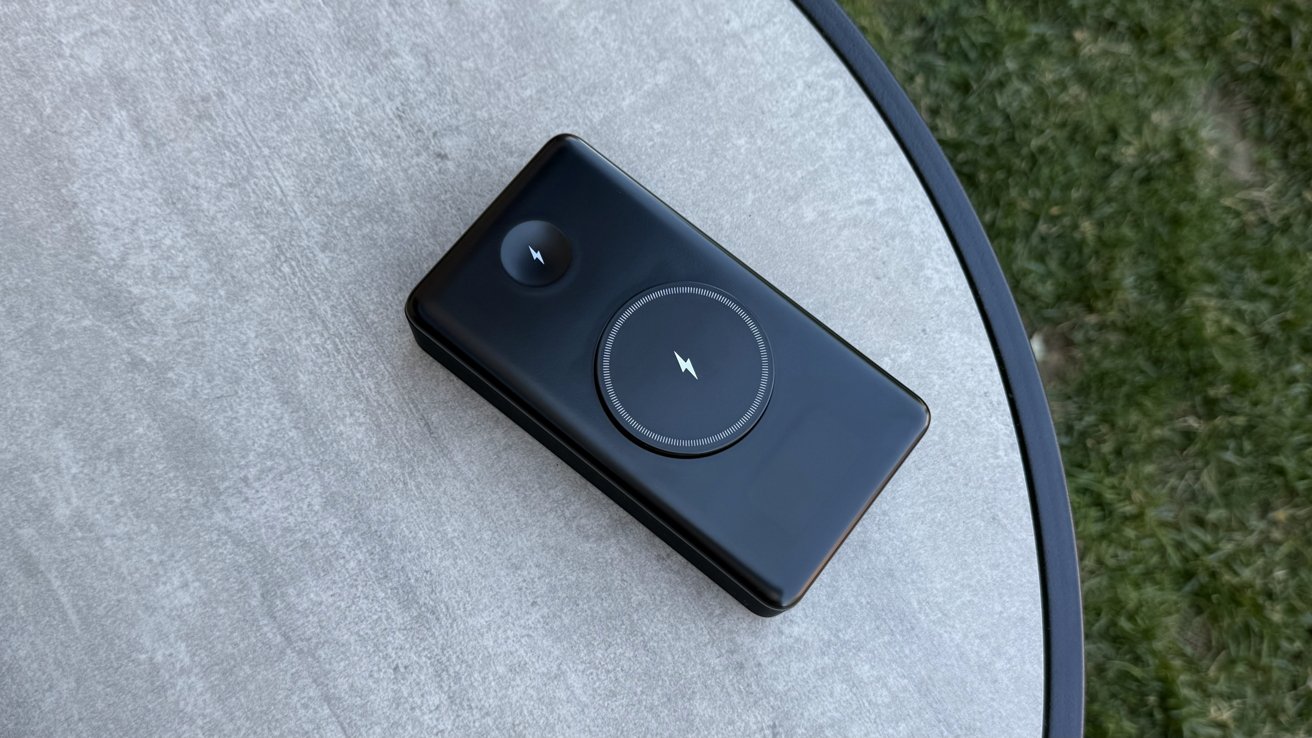
Chargeasap Flash Pro Ultra review: plenty of power and ports
Chargeasap has been around for a while, and this is the third iteration of the Flash power bank I've reviewed. The Flash Pro Ultra takes everything that the company has learned from the previous models to combine it into a single sleek device.
The travel-friendly power bank is rated at 25,000 mAh and can output 275W at once. Passthrough charging also means it can act as a charging hub for five products via AC power without touching the battery.
I reviewed the Flash 2.0 in 2020 and the Flash Pro Plus in 2021. A lot of progress has been made and the Flash Pro Ultra may just be the ultimate portable power bank -- if you're willing to pay the high price.Chargeasap Flash Pro Ultra review: Design
Chargeasap has maintained its basic design through the years, but the Flash Pro Ultra departs from the sleek metal enclosures in favor of lighter plastic. It's a bit more boxy, a tad thicker, but keeps close to the same relative volume of previous models.
It's 1.5 pounds, the heaviest power bank so far compared to 1.4 pounds and 1.2 pounds from previous iterations. It's 6 inches long by 3.25 inches wide and about 1.4 inches thick.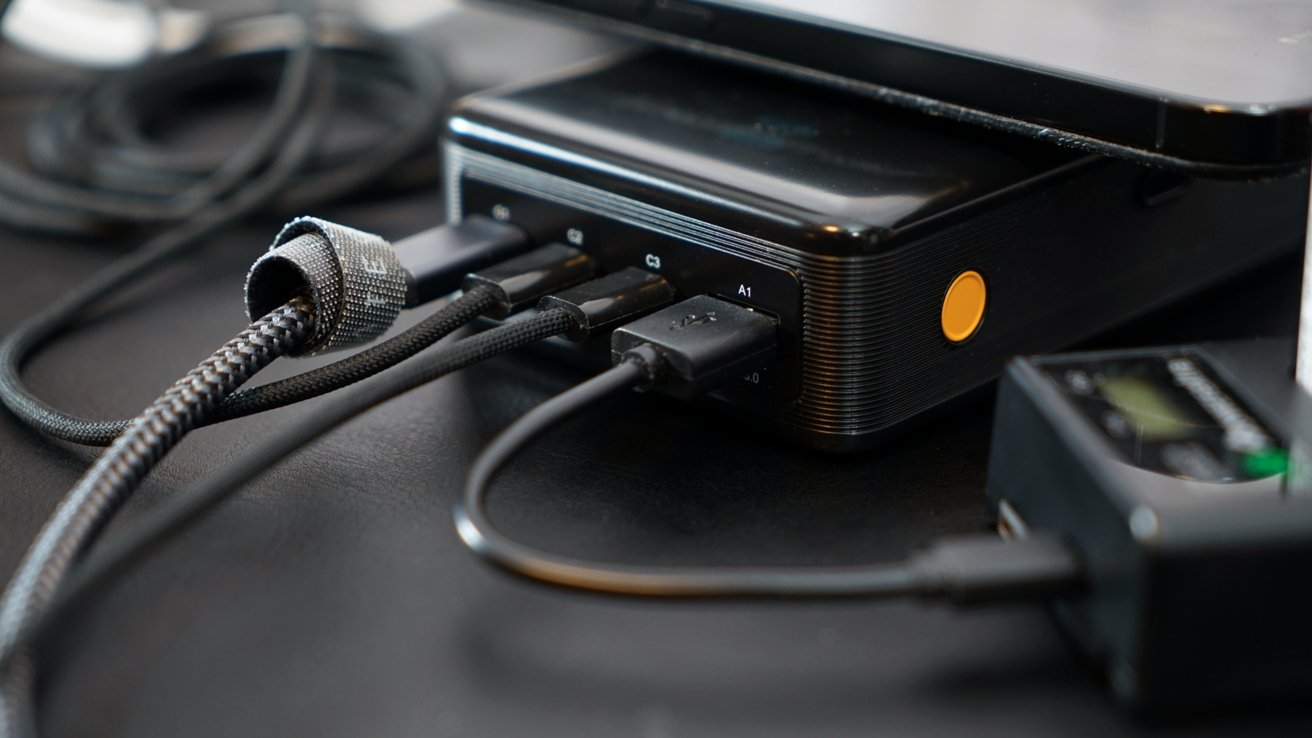
Chargeasap Flash Pro Ultra review: this chunky battery pack shouldn't go in your pants pocket
I'll never understand Chargeasap's tendency to show images of people carrying these in their back pocket -- it's not exactly pocketable and it'll weigh your pants down too much. However, it's the perfect size for most bag's internal mesh pockets.
The design is simplistic yet isn't too utilitarian. The OLED display on the front can show charging level with temperature and time remaining on one view, or show wattage output for each port in another.
The power button is easily found thanks to its yellow color, and there's an eject button that pops up the MagSafe charger on top. Both the MagSafe charger and Apple Watch Charger have a lightning bolt symbol.
The ports are located at the top of the device and have plenty of space around them so cables don't feel crowded. Each port is labeled with their max output.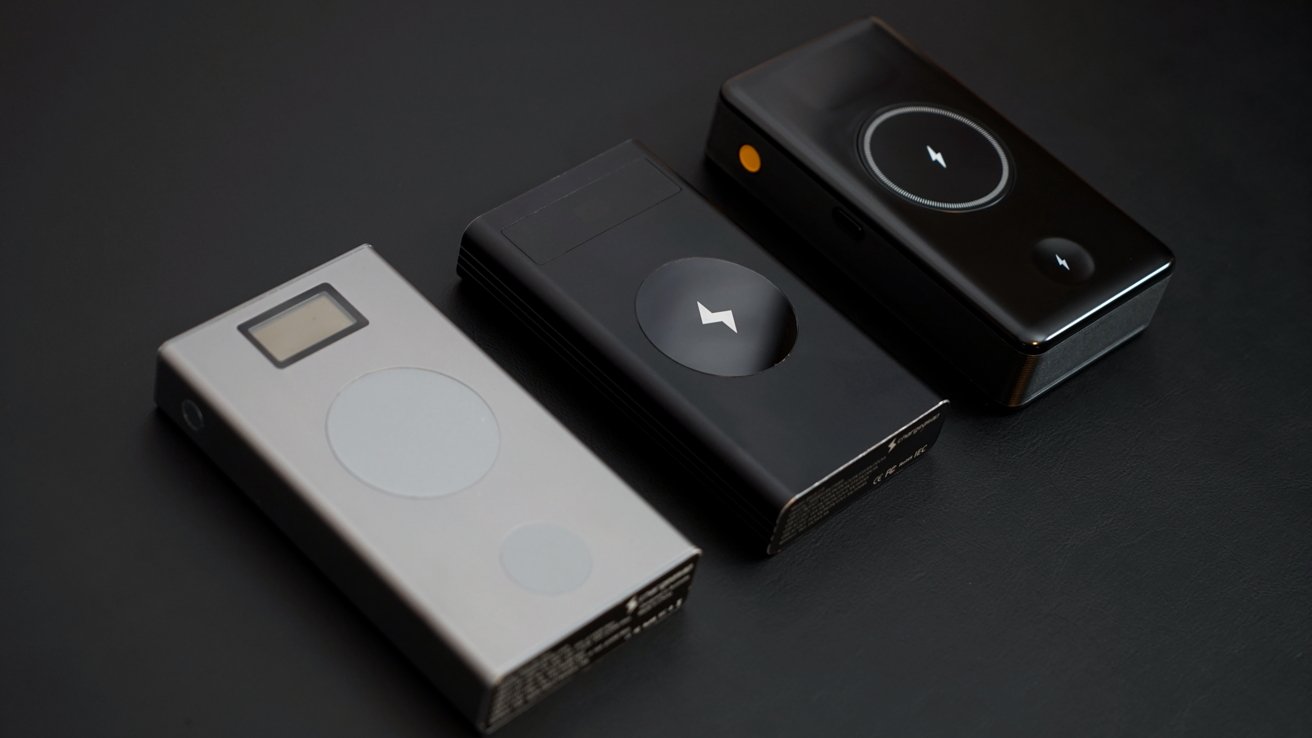
Chargeasap Flash Pro Ultra review: generations in the making
Internally, the Flash Pro Ultra is is powered by five 21700 Samsung Lithium-ion Battery Cells. This is a move that Chargeasap doesn't seem to be trying to bring much awareness to since the previous models were marketed heavily on using Panasonic graphene batteries.
This doesn't appear to matter, however, as the weight isn't much higher, it still has a 25k mAh capacity, charges fully in 70 minutes, and operates at low temperatures. Really, lithium-ion is fine in my experience.
One aspect Chargeasap was focused on with graphene was the lower operating temperatures. It seems that isn't a problem here as I've never seen the on-screen temperature indicator get too high, plus the inclusion of the temperature readout shows Chargeasap's confidence here.
In use, the battery has never been hot to the touch. That's saying something considering how blistering hot some other batteries can get.Chargeasap Flash Pro Ultra review: Features
The battery itself is quite straightforward, though it's got a great gimmick I hope other power bank producers try to copy. It can charge six devices at once, though it maxes out at 275W even though the total potential of all the ports adds up to 335W.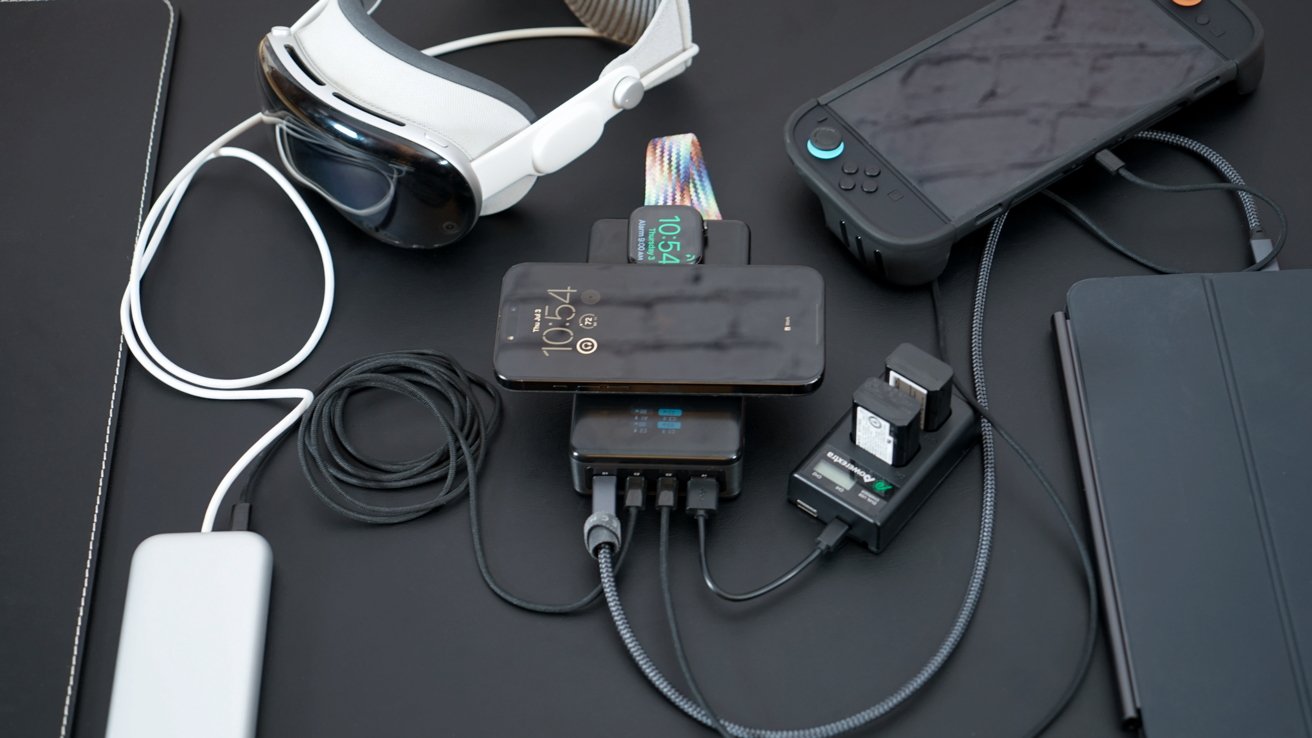
Chargeasap Flash Pro Ultra review: charge six devices at once
The MagSafe charger is Qi2 certified, so it charges up to 15W on compatible smartphones including iPhone. The Apple Watch charger is a 5W charger.
There are three USB-C ports. C1 is a 140W PD fast charger, C2 is a 100W PD fast charger, and C3 is a 60W PD fast charger.
The USB-A port is also capable of 60W, but it shares the circuit with C3, so they're limited if both are in use. If C3 is in use, A1 defaults to 15W out max.
If everything is in use, there's not really a normal use case where every connected device would ask for the max power draw. However, if that unlikely scenario happened, it seems to prioritize the first two USB-C ports.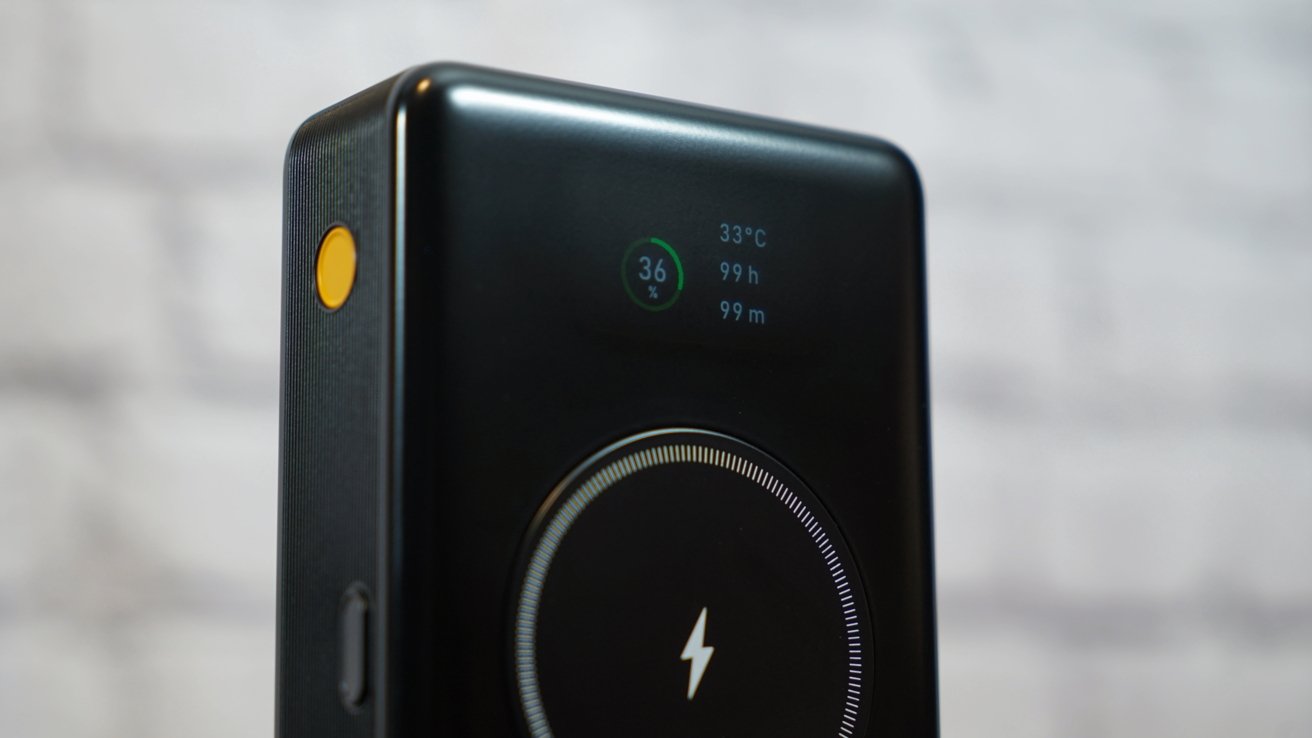
Chargeasap Flash Pro Ultra: a handy display with useful data
So, with everything connected, you'd get 140W on C1, 100W on C2, 15W across C3/A1, 15W MagSafe, and 5W on Apple Watch. Those add up to the 275W max output of the battery.
The Flash Pro Ultra also works as a passthrough charging hub. That means if the battery is connected to external AC power, the connected devices won't drain the battery.
The 25k mAh capacity allows users to recharge an iPhone 16 Pro Max four times or a MacBook Air 1.5 times. It's quite a lot of capacity for something you can slip into a bag.
Customers with a Samsung watch and phone can also purchase Chargeasap Flash Pro Ultra this time around, though they'll have to pick a specific model. There's a model with Samsung Watch charging capability built in.Using Chargeasap Flash Pro Ultra
Previous Chargeasap Flash batteries offered wireless charging, but never MagSafe. This was due to the camera bump on iPhone not allowing it to lay flat.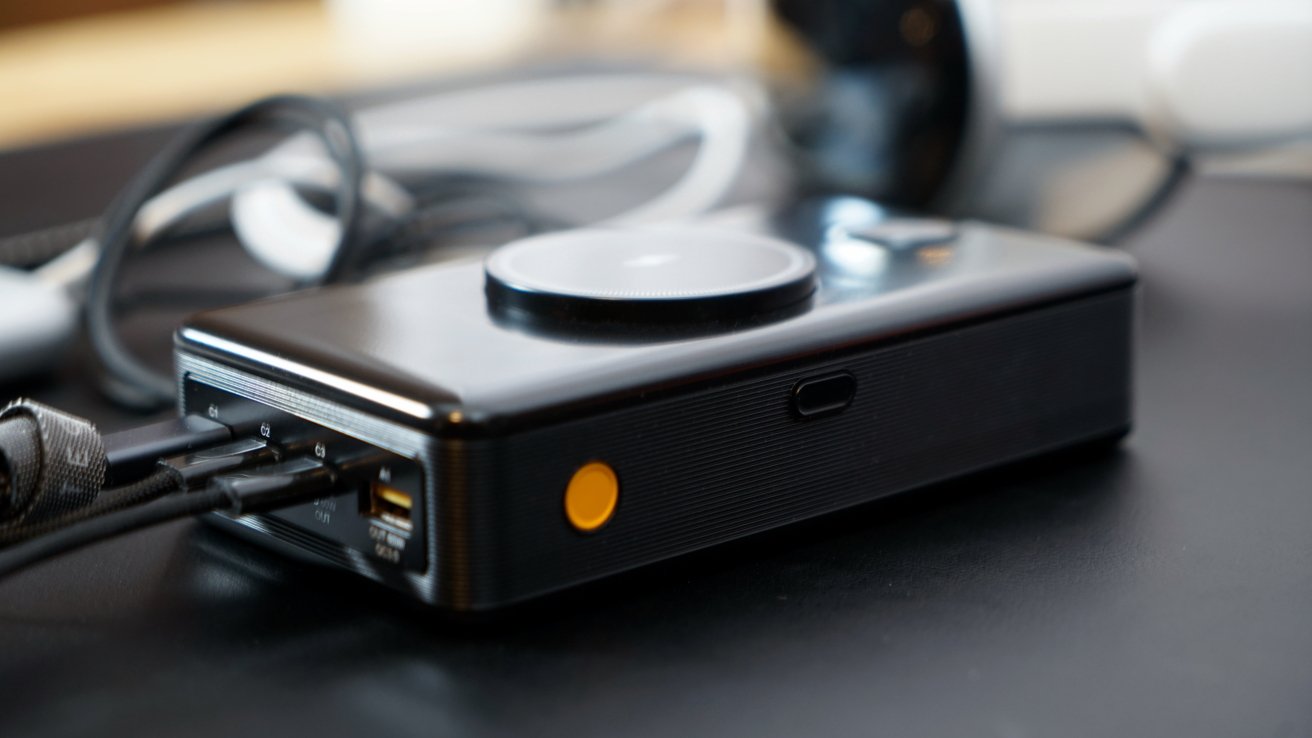
Chargeasap Flash Pro Ultra review: easily keep everything charged
The Flash Pro Ultra has a clever workaround by making the MagSafe charger pop up with a button press. It maybe could have just been permanently molded to stay up, but that could have interfered with placing it in certain pockets or cases.
The mechanism seems solid and it doesn't stick. However, I have some concern about how it will age after extensive use and exposure to the elements.
The battery is an excellent travel companion. It reduces the need for several kinds of chargers and wall adapters. One cable from the wall can charge the battery and five other devices.
That said, I've encountered one issue that's hard to determine the cause. My Apple Watch won't stay charging for long after being placed on the charger.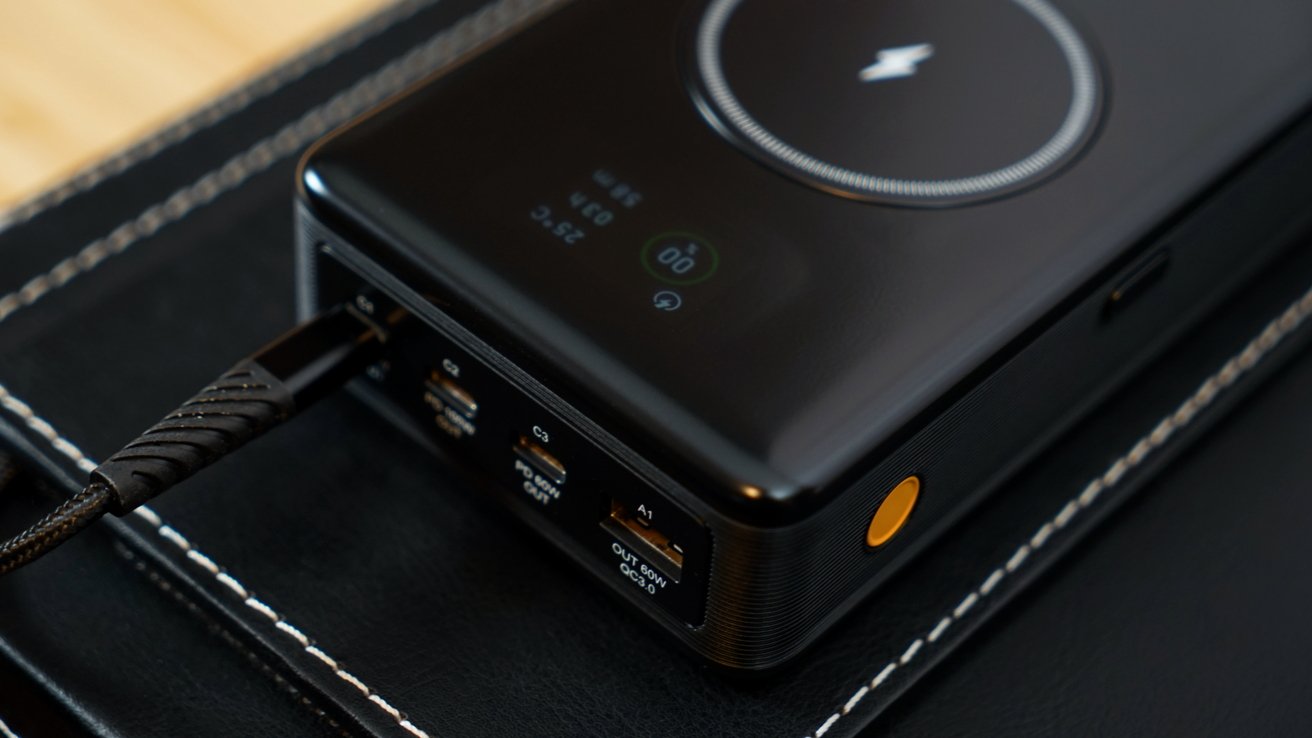
Chargeasap Flash Pro Ultra: passthrough charging turns it into a docking station
The charging animation shows up, the battery shows power is being discharged, and everything seems fine. But, when I return even moments later, the Apple Watch is no longer charging.
It isn't clear why this is occurring and could be a specific problem with my unit. Note that the issue exists, and if you purchase a battery with an Apple Watch charger that isn't working properly, expect a replacement unit or refund.
Otherwise, the battery has been excellent. Whether I'm using it to keep my Nintendo Switch alive while out and about, or to power my iPad Pro while working outdoors, it's a well-made, reliable and powerful portable battery pack.Ultimate portable power at a price
I expect Chargeasap will continue to iterate on the Flash lineup, but this model will likely last a number of years before a revision is needed. As long as the Apple Watch charging issue isn't persistent across all devices sold, it's a solid product.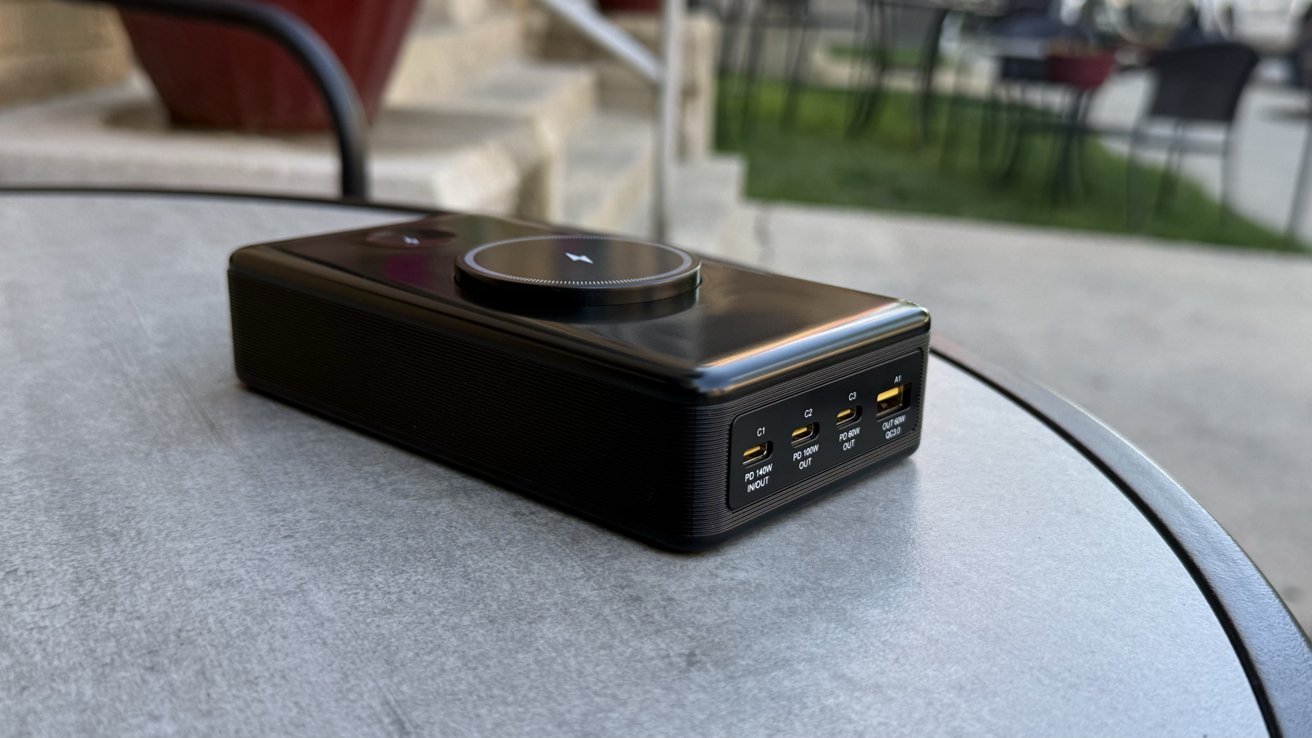
Chargeasap Flash Pro Ultra review: ultimate power comes at a price
The high price is still a difficult one to overcome. It is worth the price, but most users will likely go for cheaper, more limited battery packs.
Instead of juggling multiple power banks and chargers, use the Flash Pro Ultra. It's been my go-to power bank since I began testing it, and it is a big step up from the previous model.
It's especially useful for Apple fans since it can provide 140W fast charging to MacBook Pro and is compatible with every product in the lineup. Charge everything from iPads to AirPods with PD charging that won't damage your batteries.Chargeasap Flash Pro Ultra review - Pros
- Good size to capacity ratio
- Passthrough charging
- Incredible 140W output, 275W total
- Pop-up MagSafe charger is innovative
- Doesn't get too hot during use
Chargeasap Flash Pro Ultra review - Cons
- Apple Watch charging issue (may be limited to my unit)
- High price may deter customers
Rating 4.0 out of 5
As much as I've enjoyed the premium power banks made by Chargeasap, they can't seem to escape one or two odd issues and that price tag. It's a 5 if you get one that has a working Apple Watch charger and the price isn't an issue.Where to buy the Chargeasap Flash Pro Ultra
Get the Chargeasap Flash Pro Ultra for $329 from the Chargeasap website. It launched after a successful Kickstarter, marking the company's 13th successful fundraiser.
Read on AppleInsider
-
Apple Maps still calls it the Gulf of Mexico, and politicians are upset
President Trump signed an executive order demanding that many landmarks change their names, including the Gulf of Mexico, but Apple Maps hasn't changed. Here's why it isn't quite that simple.
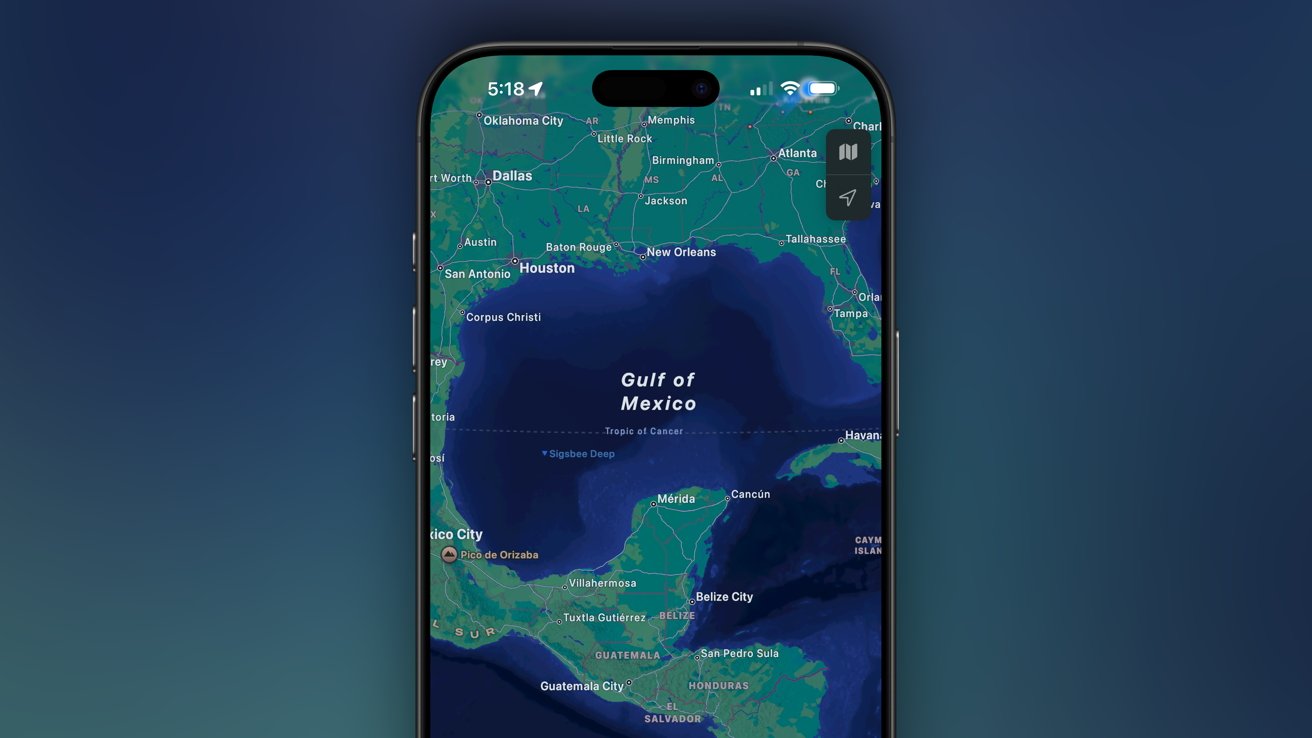
The Gulf of Mexico remains in Apple Maps
Maps are a funny thing. For a long time, we studied global geography using a map designed in 1569, but it inaccurately shows North America and Europe as much larger than they should be.
Nearly five hundred years later, we've started adapting more recent models that accurately show continent size. I bring this up simply because maps are complicated and changing the ones we rely on can take a lot of time and effort.
So, when the returning President Trump signed an executive order to change the names of landmarks, it should be easy to understand that it isn't quite so simple. Even if the U.S. Board on Geographic Names (BGN) standardizes the "Gulf of America," it only has authority over US federal uses.
Executive orders can only be given to federal or state agencies, not to the general public or private corporations. So, there is no direct ability for any entity to demand that Apple or Google change their mapping systems.
You would think that Representative Dan Crenshaw of Texas would know these things, but he posted on X anyway.Hey @tim_cook, just noticed Apple Maps still calls it the Gulf of Mexico. Sent a report through the app, but thought you'd want to know! pic.twitter.com/fA7cWtOGY1
-- Dan Crenshaw (@DanCrenshawTX)
The BGN in the US can direct federal agencies to adopt the name, but the rest of the world likely will still refer to that body of water as the Gulf of Mexico. The United Nations Group of Experts on Geographical Names (UNGEN) is a group that works with all of the member countries to create a standard, and it seems unlikely that anyone else would be willing to adopt such a superfluous name change.
Apple and Google are global companies that serve everyone maps. They utilize a combination of their own data and public resources to map, name, and lay out everything for users.
The Gulf of Mexico has been called as much for over 400 years. The name comes from Aztec origins since those were the people that resided in the region when the Americas were colonized.
Other countries, generally ones with authoritarian rulers, have tried to coerce Apple and Google to change place names on maps. Like how Russia disagrees with what land Ukraine owns, or that China doesn't observe Taiwan as a separate entity.
The standardization of names on a map has always held some importance in ensuring everyone reading the map around the world understood what they were looking at. Many countries that don't use English as their primary language have different names than what are shown on the standardized map. For example, Japan is actually Nihon and Germany is actually Deutschland.
Perhaps the executive order will lead to paper maps and student handbooks showing the Gulf of America in the United States. To the rest of the world -- including the US military that adheres to international naming conventions -- it'll be the Gulf of Mexico.
If Crenshaw is upset, perhaps he should start by directing his ire at the BGN, which still lists the Gulf of Mexico in its database. Meanwhile, it seems highly unlikely that Apple will change the name of the location because of one country's demands.
Read on AppleInsider


-
Five ways iPadOS 26 turns iPad into a productivity powerhouse
Apple has pushed its iPad platform further than ever with iPadOS 26, and it goes well beyond a redesign. Here are five features that could make an iPad your next computer replacement.
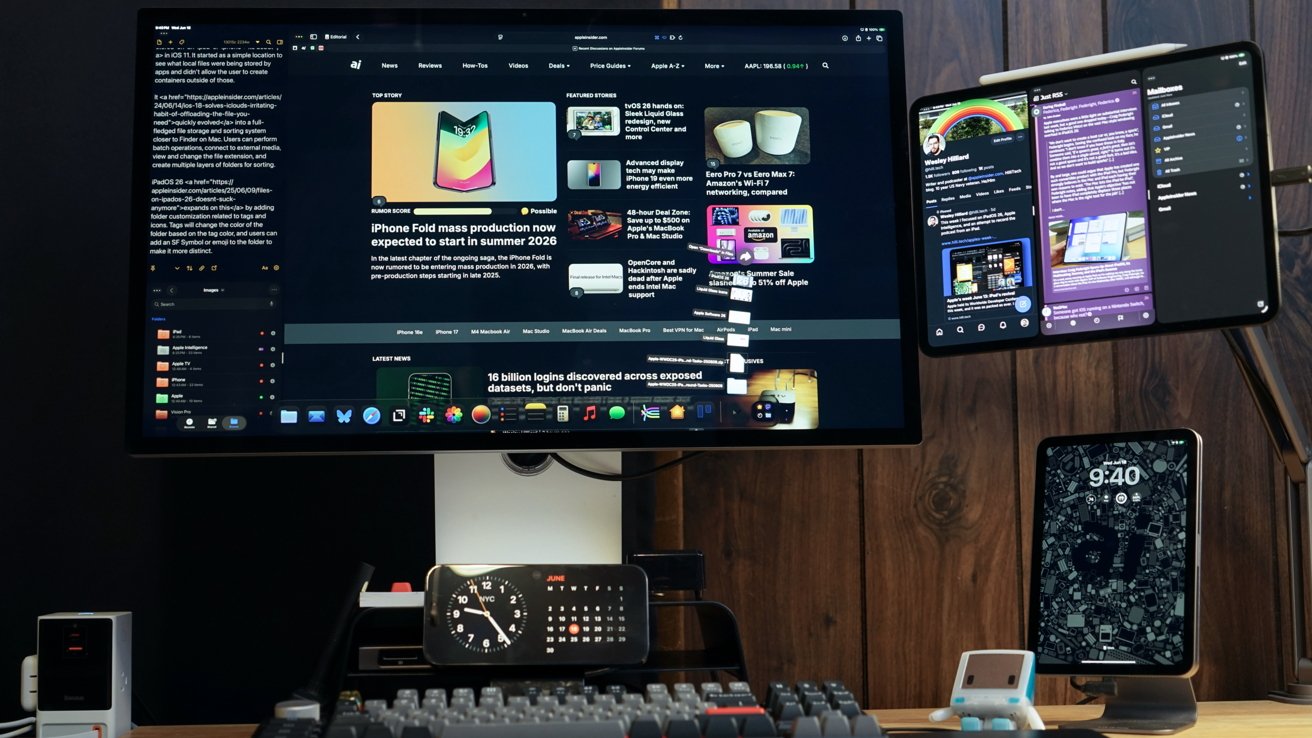
iPadOS 26 is a big productivity boost with new windowing and files management
There has been a lot of debate around iPad's place in Apple's lineup, especially since the iPad Pro first appeared in 2015. After a lot of updates tried to bring iPad closer to the Mac experience without replacing it with macOS entirely, iPadOS 26 takes the biggest step yet.
Here are five features that take iPad from a possible computer replacement to a definite option for many users.1. Windowing
Apple threw out the original multitasking paradigm of Split View and Slide Over with iPadOS 26. Stage Manager is still here as an expanded option, with windowed apps available as the default.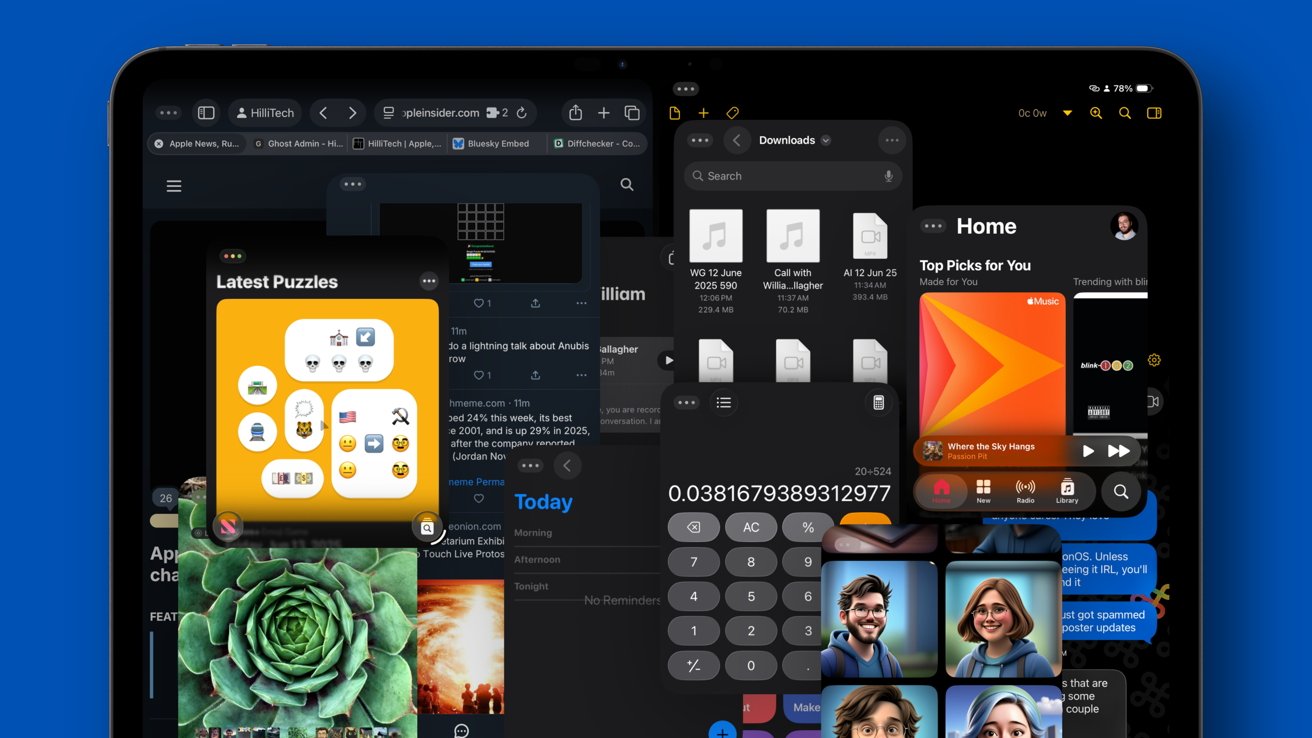
iPadOS 26 introduces an entirely new windowing system
Users can choose to revert to the multitasking system to single, full-screen apps if they'd prefer the classic iPad experience.
The windowed apps setting is like a classic desktop where each window opens into the space. They can be arranged, resized, tiled, or minimized as you'd expect.
Stage Manager works as you'd expect, though the four-app limit is gone. Clicking on an app opens it in a new stage, while holding Shift and clicking opens it in the current stage.
The iPadOS 26 windowing system is different from previous multitasking attempts because it allows near-infinite window resizing and shapes. It also allows windows to overlap, stack, or set in any manner without being forced into a specific shape or space.
There's now a set of traffic light controls that are visible depending on how the windows are laid out. Full-screen apps have their traffic lights hidden in the new menu bar, while tiled apps show the traffic lights at all times at the top right of a window.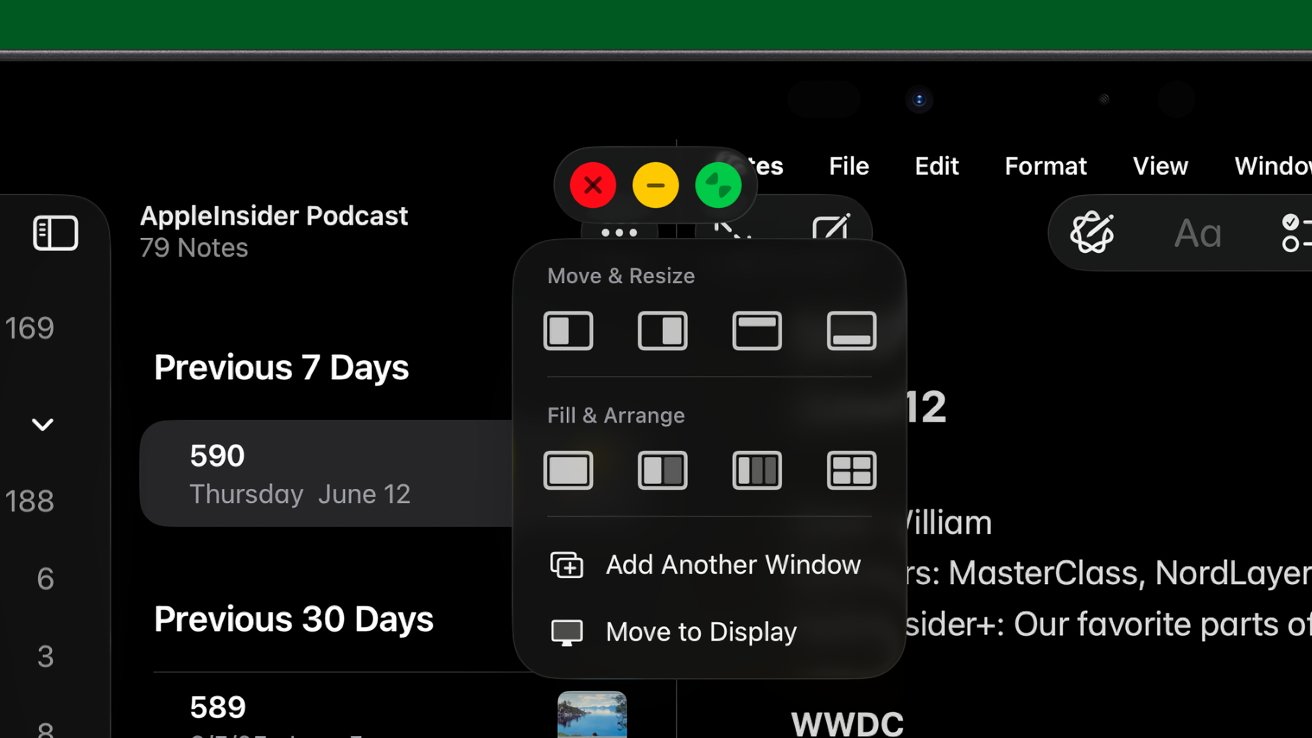
Classic traffic lights are now part of iPadOS 26
Speaking of which, the menu bar brings access to general app functions that hide when not in use. It is placed at the top of the screen in otherwise wasted space occupied by the status bar.
Users could access these functions previously by holding down the Command key on a keyboard. The new menu bar ensures these functions are always accessible, even when in touch mode.
These upgrades not only make multitasking easier, they make it more accessible. The paradigm is similar to windowing on other operating systems, which provides instant familiarity to all users.2. Background tasks
Background tasks will be a game changer once iPadOS 26 launches in the fall. It will allow users to switch to a different app while an export is still in progress, which wasn't possible before.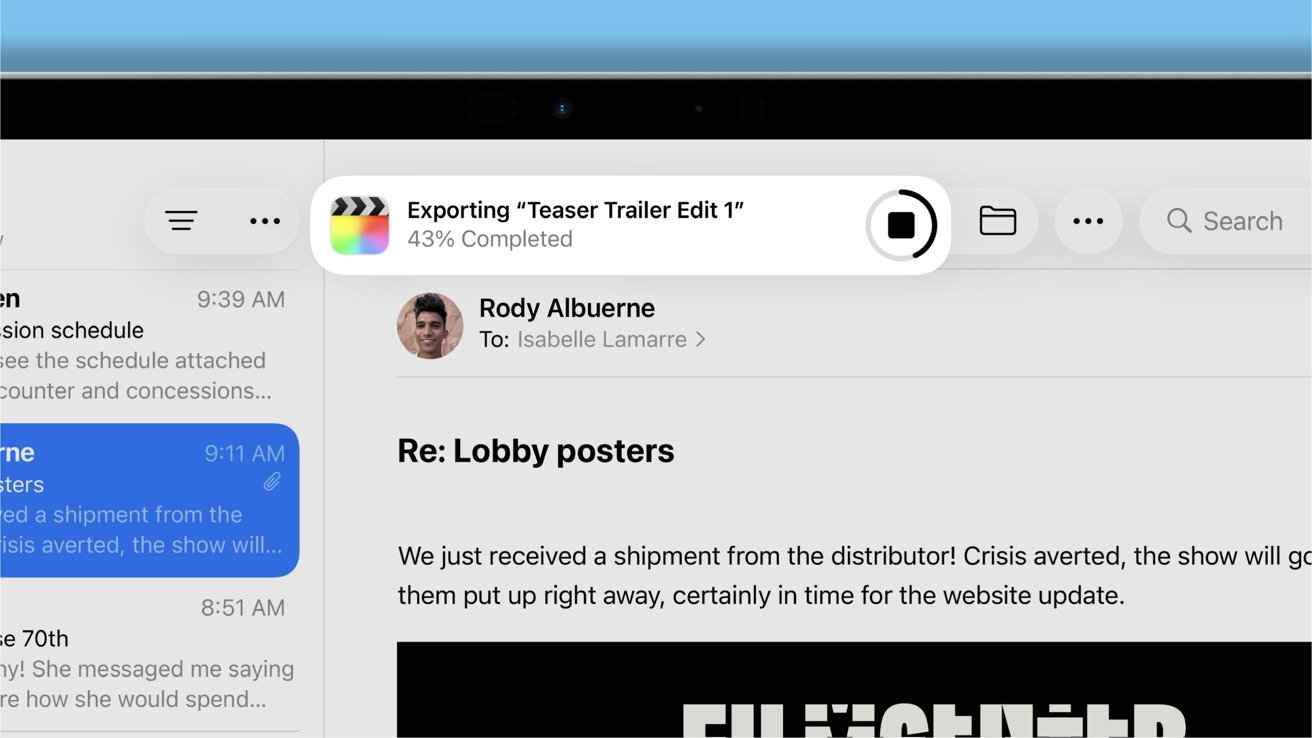
Background tasks are now possible and keep the user updated with a Live Activity
Today, if you try to export something from an app like iMovie and switch apps, the process will be stopped. iMovie in particular warns users that it must remain in the foreground until the export is complete.
The background task update won't be testable until apps update to take advantage of it.
Everyone from casual users stitching together birthday party footage to pros creating their next YouTube video have encountered this issue in the past. It's especially compounded now that iPhones can capture footage in ProRes 4K 60Hz.
When a background task is in progress, the user will be shown via a Live Activity that appears at the top of the display. A progress bar will show when the process should complete.
It's a self-explanatory feature that should have been in iPadOS 26 years ago. With this addition, many more workflows will become possible on iPad.3. Audio recording
There has been a kind of myth, a legend even, about Apple realizing that its users couldn't podcast from its most popular products. Every year it seemed that Apple would never provide the tiniest of features to enable local audio recording or audio intent controls, but it is finally here.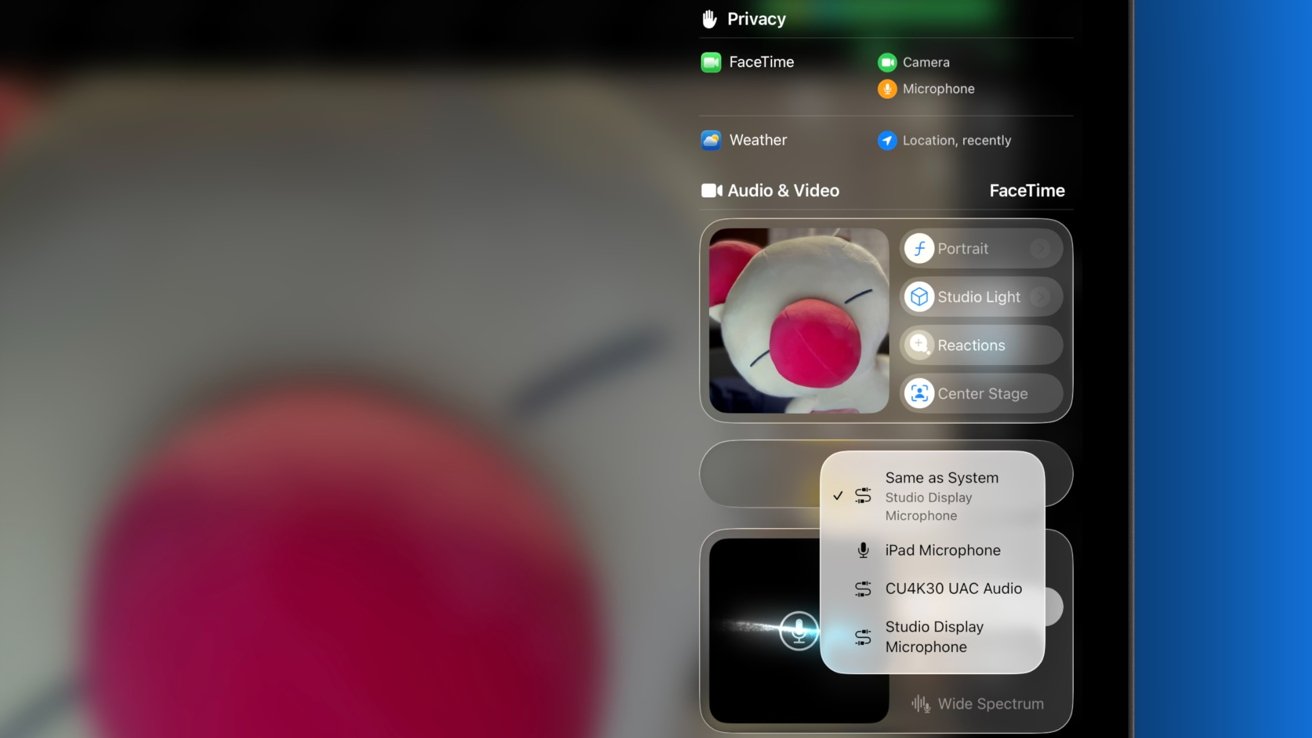
iPad users can choose between connected microphones in iPadOS 26
Starting with iPadOS 26, users can capture local audio from any connected or integrated microphone. The audio is saved automatically to the Downloads folder in the Files app.
The new audio intent controls also let users choose which microphone is active on a per-application basis. This is a big deal for users connecting multiple products over a dock to an iPad.
For example, if you wanted to stream the feed from a game console while capturing both your local mic audio and the game audio, it wouldn't be possible before without a complicated workaround. Now, everything works, as users can just designate which audio goes where.
I've wanted to record the AppleInsider Podcast from iPad for ages since that's my primary computing platform. It worked before by making a call on iPhone and recording on iPad, but that created an awkward system prone to failure.
The new system is similar to Mac, except it's a built-in system feature instead of relying on QuickTime to capture audio. You can call someone on FaceTime, record locally to the Files app, and simultaneously record the call to the Notes app using that separate feature.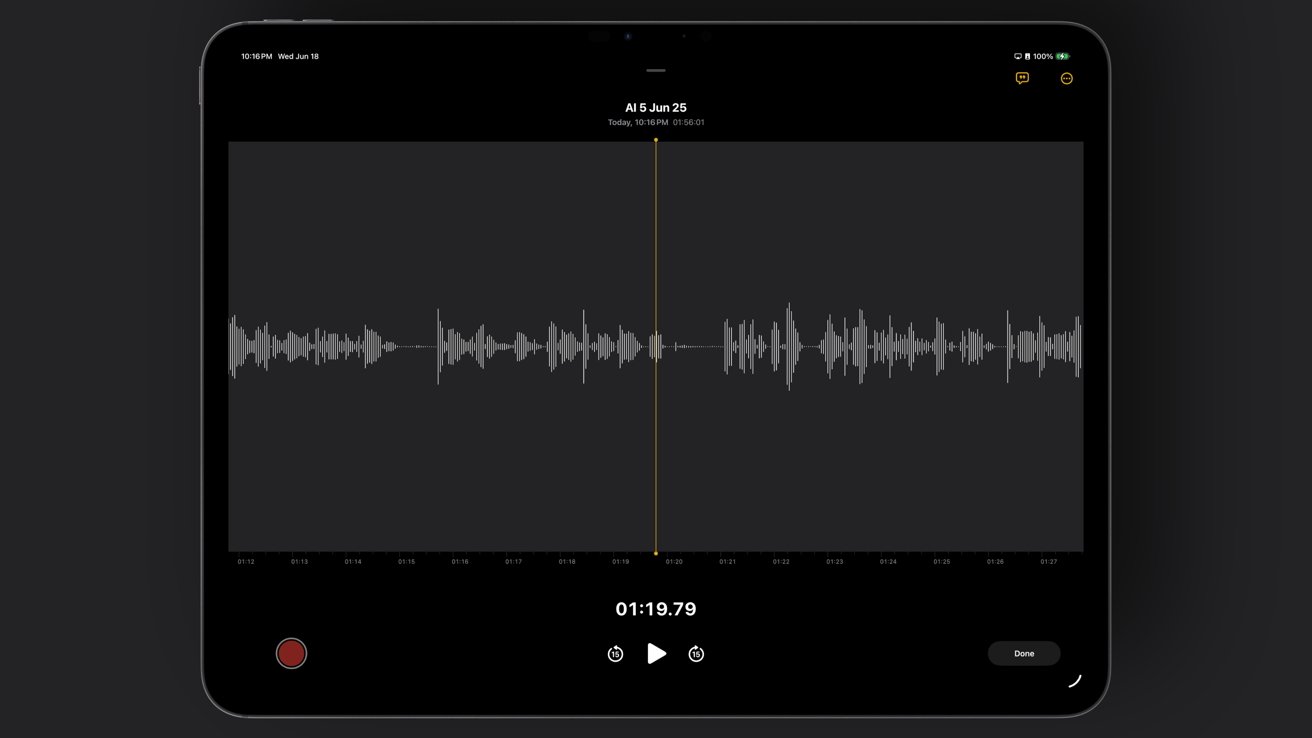
Record a FaceTime call and it shows up as an audio file in a shared Note
The result is a track that mixes both callers into one audio file and a track that's just the direct input from the microphone. There's one problem with the current setup, though Apple could correct it by the end of the beta period.
If your mic doesn't have any gain control, then you're not going to be able to control the input volume of the mic. It's full blast no matter what you do, so a mic with gain control or an external audio controller will be necessary.
It's a minor inconvenience compared to what used to be required to record a podcast on iPad. Once third-party apps can update for iPadOS 26, there's likely going to be a lot more options and controls for users.4. Files & Preview
The Files app has been a bit of an oddity since its debut in iOS 11. It started as a simple location to see what local files were being stored by apps and didn't allow the user to create containers outside of those.
Apple's Files app gets an upgrade with customization and new features
It quickly evolved into a full-fledged file storage and sorting system closer to Finder on Mac. Users can perform batch operations, connect to external media, view and change the file extension, and create multiple layers of folders for sorting.
iPadOS 26 expands on this by adding folder customization related to tags and icons. Tags will change the color of the folder based on the tag color, and users can add an SF Symbol or emoji to the folder to make it more distinct.
The coloring system is a bit chaotic in the first beta. There's no way of knowing which color will be used if more than one tag is assigned to a folder, for example.
Also, if you edit a tag name from the sidebar, it leaves the old tag on all of the items, and the tag becomes a new tag. There's no easy way to change the name of a tag without going back and assigning it to every item manually again.
The list view also gets a new function where users can adjust the size of each column. Add more data points via the ellipsis on the right.
Files also benefit from the new Background Tasks function. Downloads from Safari, file transfers, and other extended operations are moved to a Live Activity.
Another Mac feature has made its way to iPadOS 26 -- folders in the dock. The folder will open in a fan or a grid, depending on the chosen setting. The Downloads folder is in the dock by default but can be removed.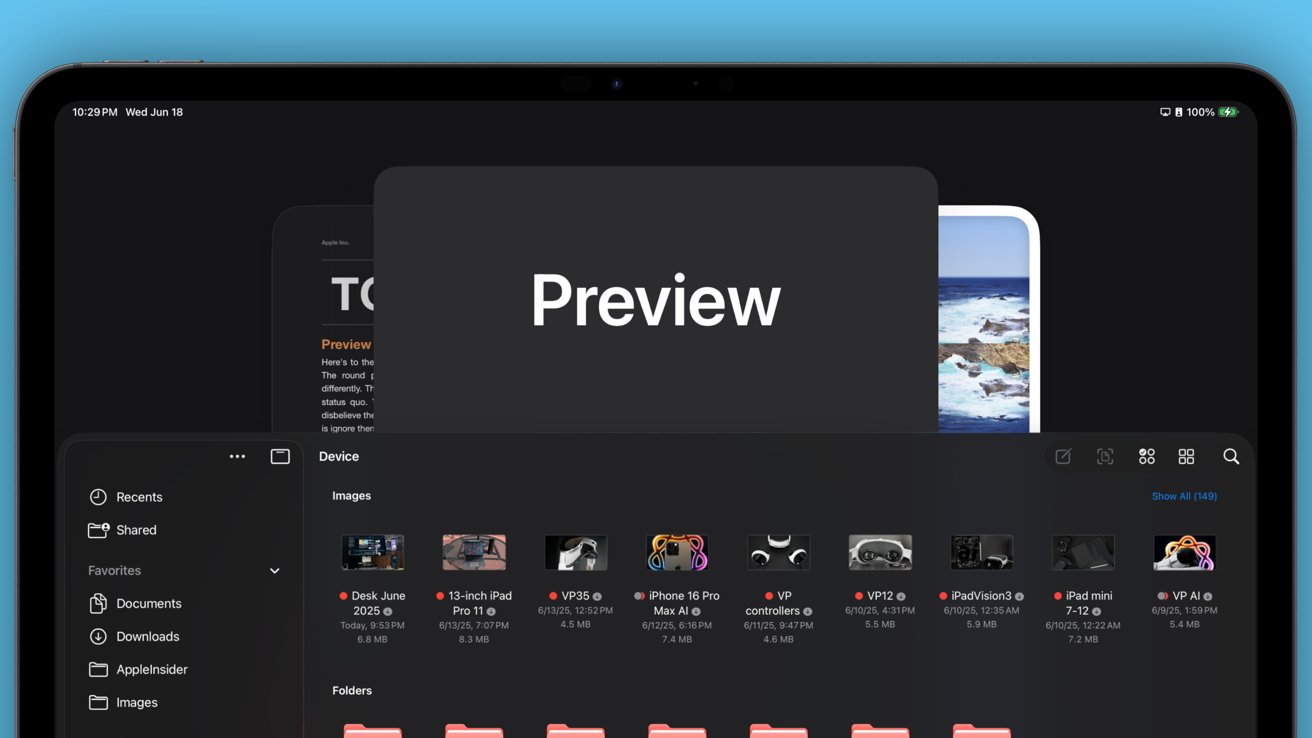
Preview arrives on iPad
Preview is a new app for iPad and totally separate from Files, but I wanted to include it here because of its relationship to Files. Previously, when clicking on a document that didn't have an app destination, Quick View would preview the file.
That method worked for the most part, but it got messy, and Quick View had to be dismissed to view a different file. Preview brings functionality that was otherwise missing from iPadOS -- a destination for documents that otherwise don't have one.
Opening a PDF or image from Files will open Preview by default. Users can annotate them and perform basic functions with the system tools.
That brings us to the last great feature added to Files, which should be one that impacts workflows the most. Users can now set a default app to open for specific files and extension types.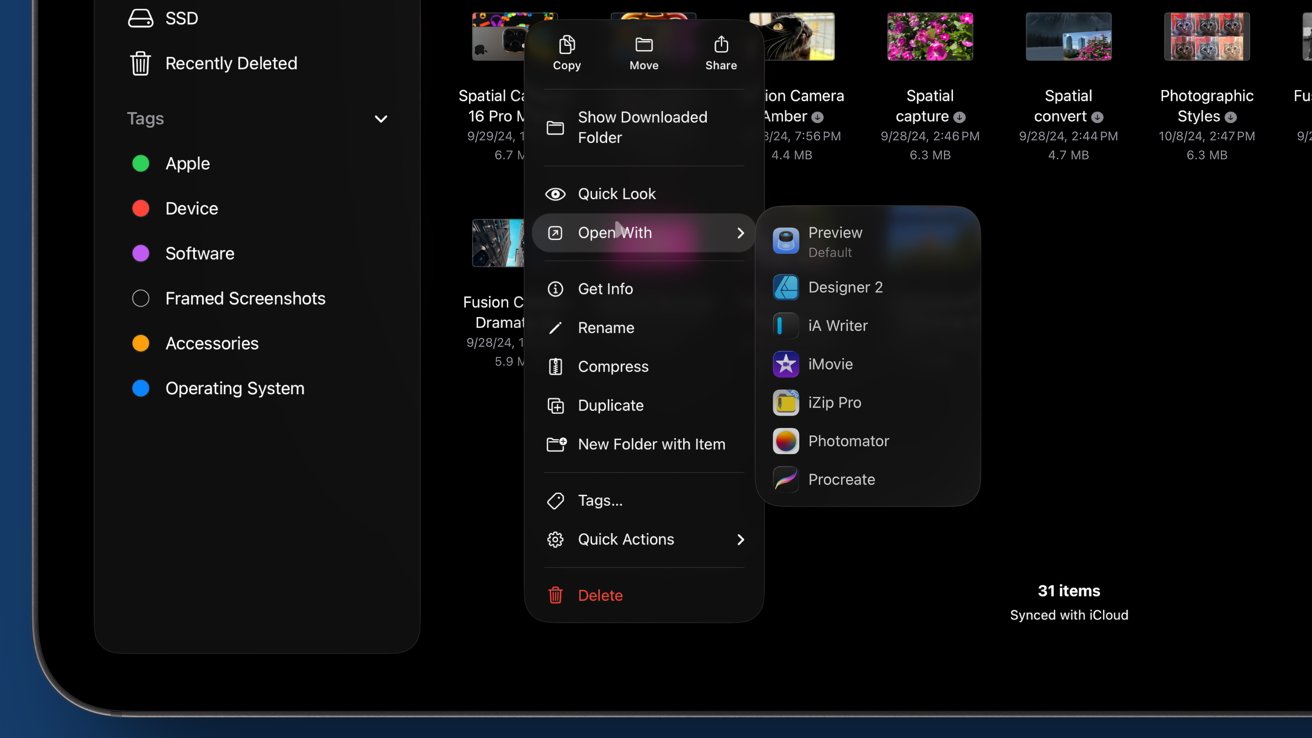
Open files into different apps or select new defaults for entire extension categories
For the longest time, .txt files opened in Provenance because it took them as configuration files. I can now designate IA Writer as the default for all .txt files.
Although, if I did have a configuration file for Provenance, I could designate that app as a default for that file alone.
These updates make using Files much more intuitive and useful, though there's still room for improvement. Power users and fans of the Mac Finder will still find Files limited in some respects.5. Apple Intelligence & filtering
The fifth feature is more of an ecosystem-wide set of on-device intelligence than a single, specific item. Apple's advancement of Apple Intelligence shows up in many ways across iPadOS 26.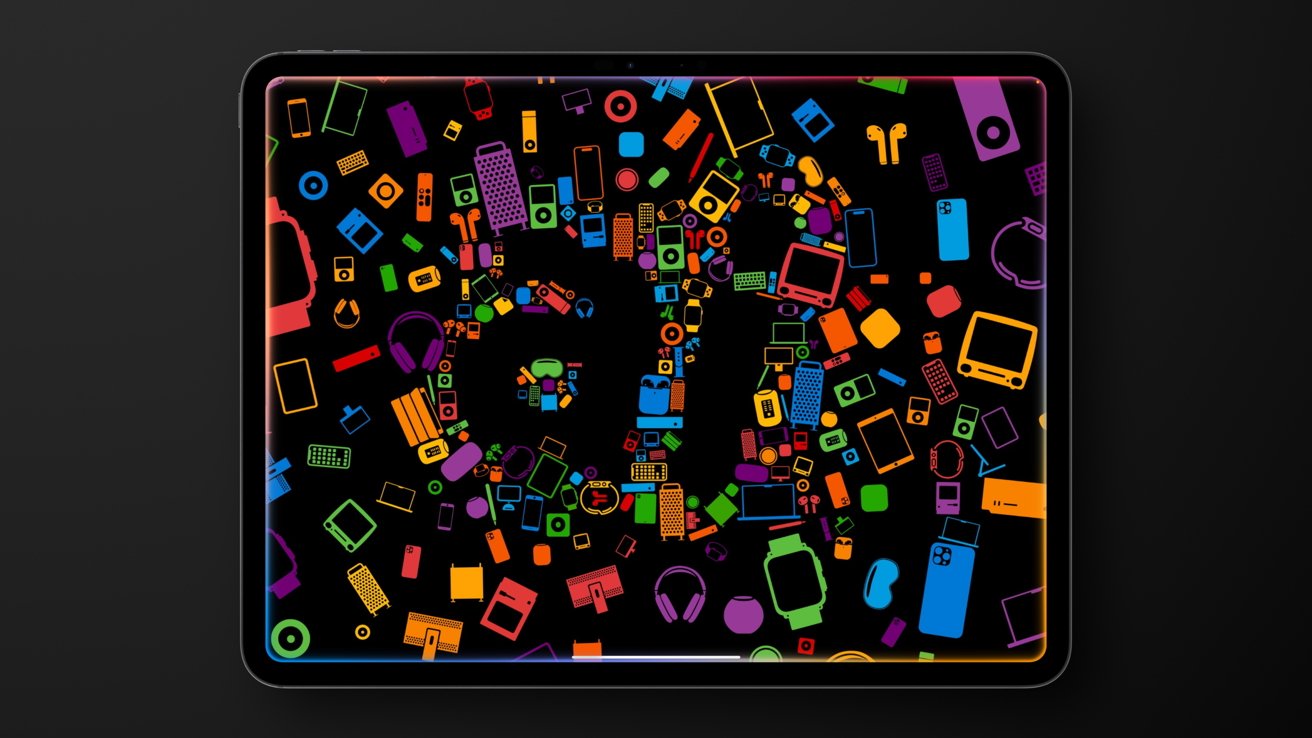
Apple Intelligence continues to improve in iPadOS 26
Apple shared that it didn't want Apple Intelligence to be a destination or even have users realize they were using it. This sentiment has led to a blur between what was previously considered machine learning and what is now AI.
The on-device intelligence, whatever the backend, is more powerful than ever. Several features focus on being more proactive with user data and taking action given certain conditions.
Apple Intelligence specifically got an update to include Live Translation across Messages, FaceTime, and the Phone. This will be a productivity boost for many that rely on iPad as their computer for international business.
Users can also tap into Apple Intelligence and ChatGPT via Shortcuts. Writing Tools and Image Playground offer specific actions, but more importantly, users can target specific models with generalized text inputs.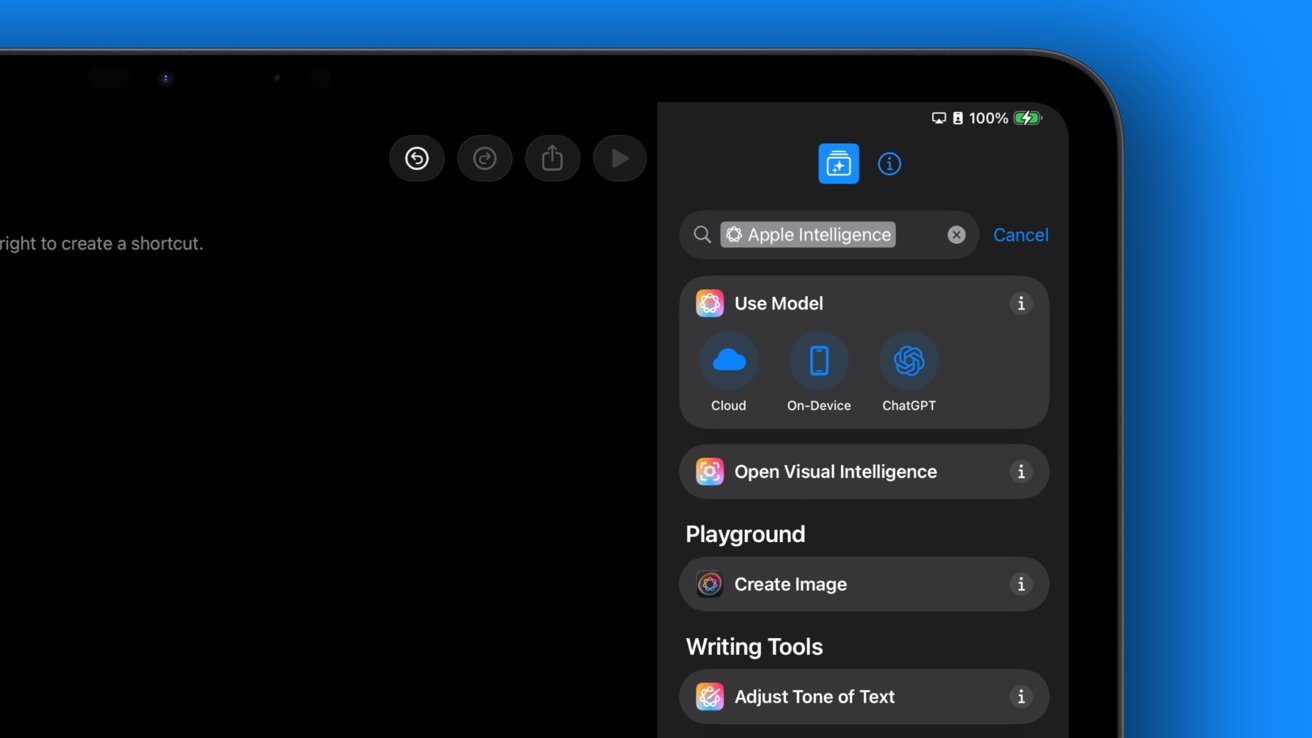
Apple Intelligence is now available as a block in Shortcuts
This will prove to be a powerful tool for several workflows. For example, a user could record a conversation via Notes and share that transcription to a Shortcut that provides an outline with key points.
If you're already a Shortcuts user, Apple Intelligence actions could dramatically change how your shortcuts function. It is also a more private way of interacting with AI with your data.
Apple Intelligence also comes to Reminders with a new sorting function. There are also new Reminders suggestions generated by Apple Intelligence that will appear across the system, like in Mail, Safari, or other apps.
An honorable mention that isn't technically AI is the new iCloud Mail Cleanup feature. It's basically mail rules from the Mac app, but there are some defaults included in addition to the ability to create your own.
iCloud Mail Cleanup and new recommendations help with productivity in email
Users can now choose how to handle old promotions, updates, and transactions based on how they've been categorized and how long they've been in the inbox. Mail will also make recommendations to unsubscribe to mailing lists you often delete or don't read.
As each of Apple's default apps gains new functions, it means less need for the user to fuss over details. Proactive Apple Intelligence and new sorting features in Mail help ratchet up productivity for iPad users.
These highlighted features are just the beginning of the benefits offered by iPadOS 26. As developers update their apps to take advantage of the new design and APIs, users will have access to more time-saving functions.
The developer beta for iPadOS 26 has barely just begun, and a public beta is expected in July. AppleInsider doesn't recommend installing betas, but you don't have too long to wait, as Apple is expected to release iPadOS 26 and the rest in September after the iPhone 17 event.
Read on AppleInsider


-
To no one's surprise, politicians are wrong about iOS 26 message filtering
The iOS 26 message filter drawing political outrage isn't new, won't enabled by default, and might actually make it easier for some texts to be seen.

Screen Unknown Senders
At WWDC 2025, Apple told users that iOS 26 will give users more control over messages from unknown senders. As a result, politicians began publicly decrying the feature, saying it'd cost them millions of dollars in political donations.
Of course, never mind the fact that the feature has existed, in some form, since 2019 with the advent of iOS 13. The feature is currently known as "Filter Unknown Senders," and while it's opt-in only, it actually does the thing that people assume iOS 26 will do -- filter out messages with no regard to content.
That means that, yes, you won't get texts from your local Department of Transportation or Secretary of State claiming that you've got outstanding toll payments. It also means that you'll miss confirmation texts for doctors' appointments, food delivery, utility companies, or family members letting you know that they got a new number.
That's why the current feature is opt-in -- it's hardly perfect.
As it turns out, the upcoming change may actually benefit the unknown senders -- and should make messaging less frustrating for users, too. The Fast Company spoke directly with Apple about what is actually going to change in iOS 26.Like a great deal of iOS 26, this is mostly a user interface update
First, the setting is getting a more accurate name. In iOS 13 through iOS 18, the feature is called "Filter Unknown Senders." In iOS 26, the feature is being rebranded as "Screen Unknown Senders."
Currently, the feature considers a sender unknown if it meets these two criteria:- The sender has not been added to your contact list or
- You've never responded to a text message from the sender
isn't changing. What is changing, however, is where you can find these filtered messages.
Apple says that the "Unknown Senders" inbox will now be easier to locate. In the top right corner, a new always-visible filter button will give users a quick way to jump between their main inbox and the unknown sender inbox.
Additionally, when you receive a text from an unknown sender, the filter button will receive a badge with a number indicating how many texts have been bounced to the unknown senders inbox.
And, as it turns out, the feature is still opt-in -- Apple isn't enabling it by default. As Fast Company puts it, "just because someone installs iOS 26 on their iPhone, texts from... political fundraising groups won't be automatically filtered out."
Ultimately, it's another case of politicians wrapping themselves in the flag, and making mountains out of molehills when it comes to big tech. Apple probably could have explained the feature a bit better, but ultimately, this probably could have been avoided had any political organization aimed before they fired.
Read on AppleInsider


